
NEW YEAR'S COLLARD WRAPS
01/02/20 — Heydon Hatcher
Recipe and Photo by Mackenzie Smith
I spent a lot of time planning for 2019 by outlining goals, talking about what I want this year to look like, and doing a lot of laundry to make sure we were headed into the new year with clean things to wear. But making the stewed black-eyed peas and collard greens and pomegranate seeds I am so excited about every year completely slipped my mind this time around. I blame it on the baby.
I love the tradition of eating black-eyed peas and collard greens to bring good luck and fortune into the new year, so even though I didn’t want to go to the store for fresh or dried black-eyed peas to stew on New Year’s day, I wasn’t about to head into 2019 without these good luck foods in my belly.
Instead of a hot pot of beans and greens, I made spicy, marinade with olive oil, lime, garlic, and hot sauce, and stirred in cubed avocados and a can black-eyed peas from the back of my pantry. Then I rooted through the fridge to find what else needed to be eaten. Cooked quinoa and the last of a roasted chicken were top priority, so I spooned both onto fresh collards from our CSA, added the black-eyed pea + avocado salsa and threw a hefty sprinkle of mint, cilantro, and pecans, wrapped it up into a pocket.
![]() Photography by Mackenzie Smith.
Photography by Mackenzie Smith.
I’ve been so into this combo since January 1 that I have gone to the store for more black-eyed peas and avocado to make it again and again. You should, too!
You’ll need:
I spent a lot of time planning for 2019 by outlining goals, talking about what I want this year to look like, and doing a lot of laundry to make sure we were headed into the new year with clean things to wear. But making the stewed black-eyed peas and collard greens and pomegranate seeds I am so excited about every year completely slipped my mind this time around. I blame it on the baby.
I love the tradition of eating black-eyed peas and collard greens to bring good luck and fortune into the new year, so even though I didn’t want to go to the store for fresh or dried black-eyed peas to stew on New Year’s day, I wasn’t about to head into 2019 without these good luck foods in my belly.
Instead of a hot pot of beans and greens, I made spicy, marinade with olive oil, lime, garlic, and hot sauce, and stirred in cubed avocados and a can black-eyed peas from the back of my pantry. Then I rooted through the fridge to find what else needed to be eaten. Cooked quinoa and the last of a roasted chicken were top priority, so I spooned both onto fresh collards from our CSA, added the black-eyed pea + avocado salsa and threw a hefty sprinkle of mint, cilantro, and pecans, wrapped it up into a pocket.
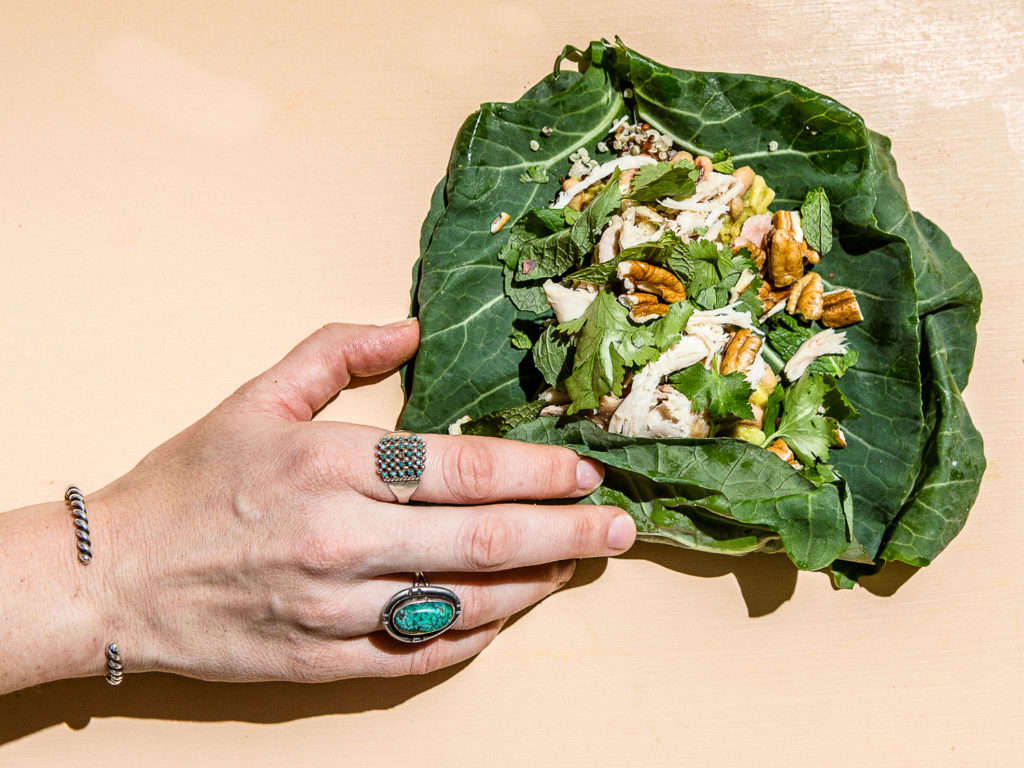 Photography by Mackenzie Smith.
Photography by Mackenzie Smith.
I’ve been so into this combo since January 1 that I have gone to the store for more black-eyed peas and avocado to make it again and again. You should, too!
You’ll need:
- 2 collard leaves per person
- Cooked grains
- Spicy Lime Avocado Black Eyed Pea Salsa
- Leftover roast chicken, shredded
- Herbs
- Pecans
- 2 tablespoons of olive oil
- Juice from half a lime
- Half a clove of garlic, grated
- Hot sauce
- Salt to taste
- 1 avocado, sliced into cubes
- 1 can of black-eyed peas
366 CHANCES TO EAT YOUR VEGGIES
01/03/20 — Ada Broussard

Each January we run a special promotion for new CSA Members: If you join before the end of January, we'll actually send you an additional (free) CSA box. If you sign up for a 4 week subscription, we'll actually deliver for 5 weeks. Join for 10, and you'll get 11 boxes brimming with winter's best vegetables. Joining the CSA this January will help you attain those aspirations to cook more, eat healthily, and fuel you body with wholesome, nourishing food. Intimidated by the variety? We've got recipes for that. Don't think the CSA will work because of your busy schedule? It's easy to skip a week. Detest beets? Simply use our customization feature to swap them out. Seriously, it's never been a better time to join our farm.

If you're a current CSA Member reading this, do your farm a favor and tell your interested friends about the January promotion. This is the only time of year we do this, and there is no better time to give the CSA a try.
If you're curious about the pickup options in your area, you can enter you zipcode on this page and see your options. If you have any other questions about what box size you should get or the differences in home delivery vs. community pickup, just give us a call or email! Our email is farm@jbgorganic.com and our farm phone is 512-386-5273. Happy 2020, y'all. It's going to be a great year of farming!
PHOTOS FROM THE FARM: 1.3.2020
01/03/20 — Ada Broussard
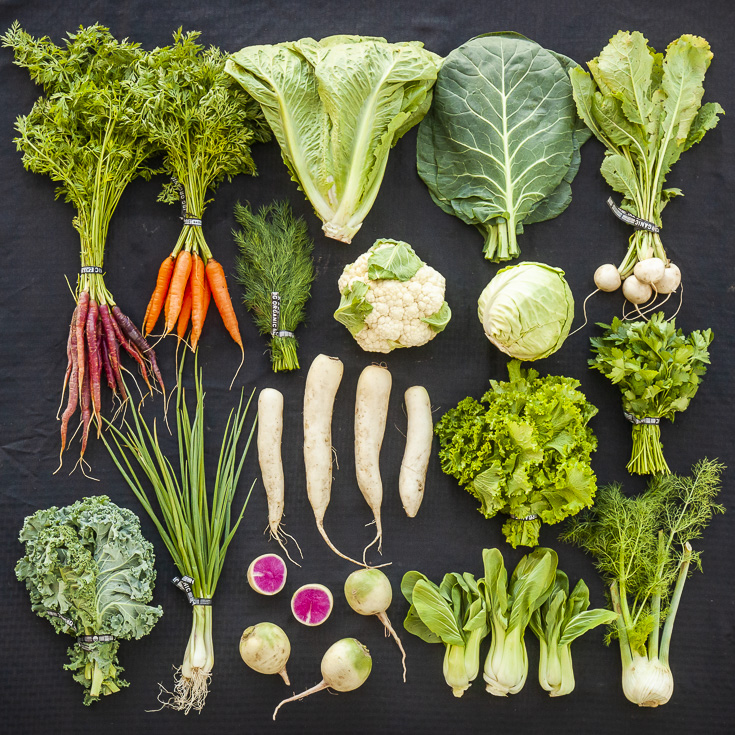 Our first CSA box of the decade does not disappoint. Thinking of giving the CSA a try? Enter FRESHIDEA2 at checkout and we'll send you a free box... as long as you join by the end of January. Beautiful box photo by Scott David Gordon.
Our first CSA box of the decade does not disappoint. Thinking of giving the CSA a try? Enter FRESHIDEA2 at checkout and we'll send you a free box... as long as you join by the end of January. Beautiful box photo by Scott David Gordon.
 Late night party at the farm? Think again. This is the crew gathering in the early morning hours, just before the night sky begins to disappear. Photo by Scott David Gordon.
Late night party at the farm? Think again. This is the crew gathering in the early morning hours, just before the night sky begins to disappear. Photo by Scott David Gordon.
 Farm dawn, everyone taking their positions. Photo by Scott David Gordon.
Farm dawn, everyone taking their positions. Photo by Scott David Gordon.
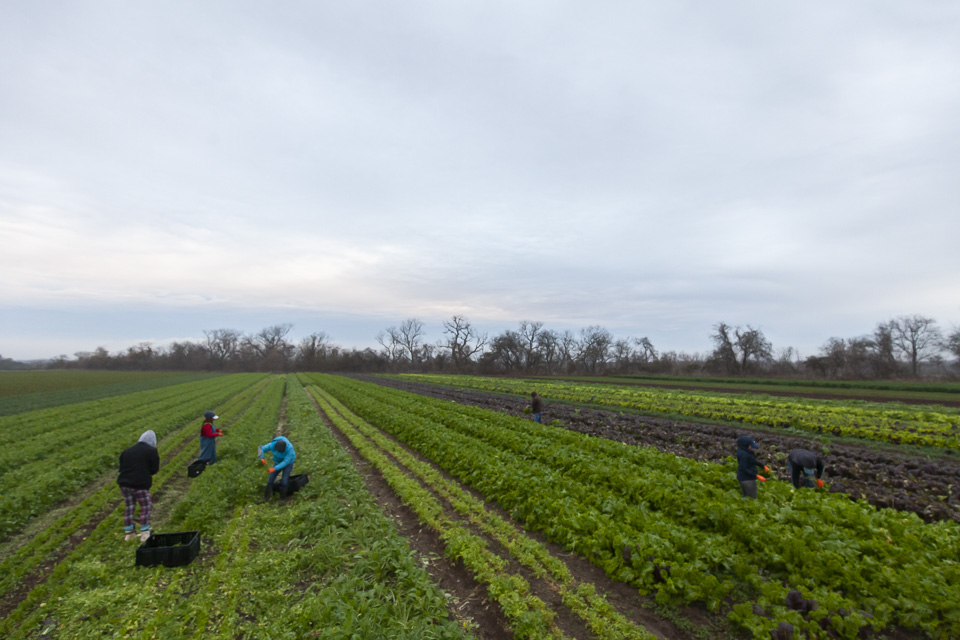 First light, shining on a new decade of farming. Photo by Scott David Gordon.
First light, shining on a new decade of farming. Photo by Scott David Gordon.
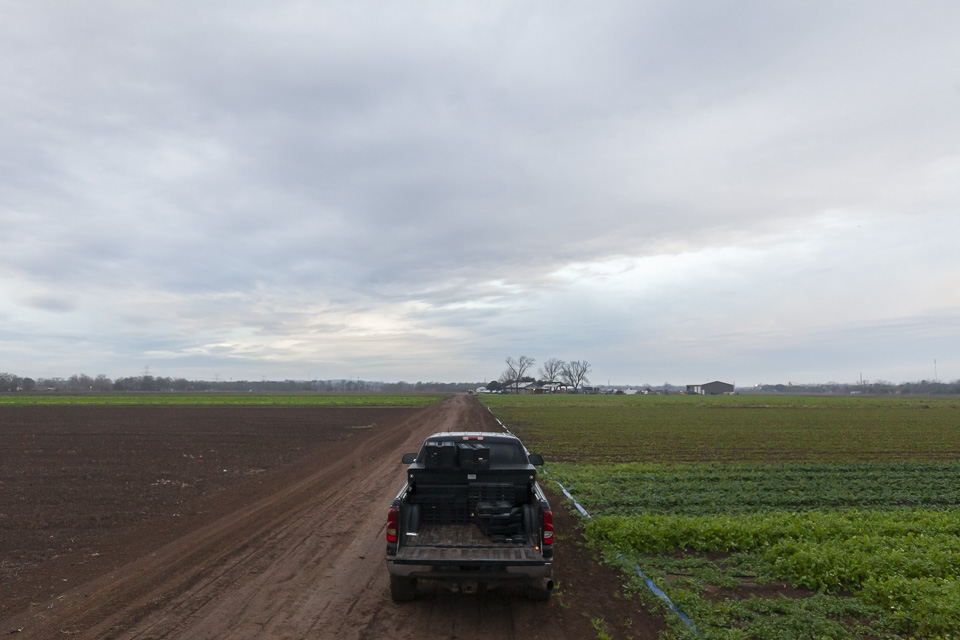 Photo by Scott David Gordon.
Photo by Scott David Gordon.
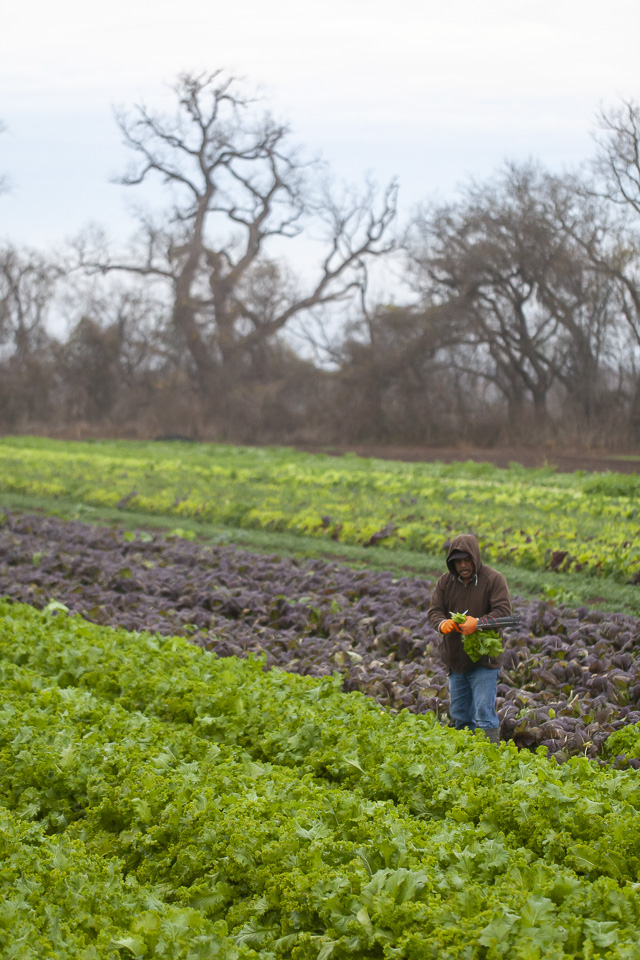 Greens so big they make our field crew look small. Photo by Scott David Gordon.
Greens so big they make our field crew look small. Photo by Scott David Gordon.
 Cutting cilantro, the world's most divisive herb. Photo by Scott David Gordon.
Cutting cilantro, the world's most divisive herb. Photo by Scott David Gordon.
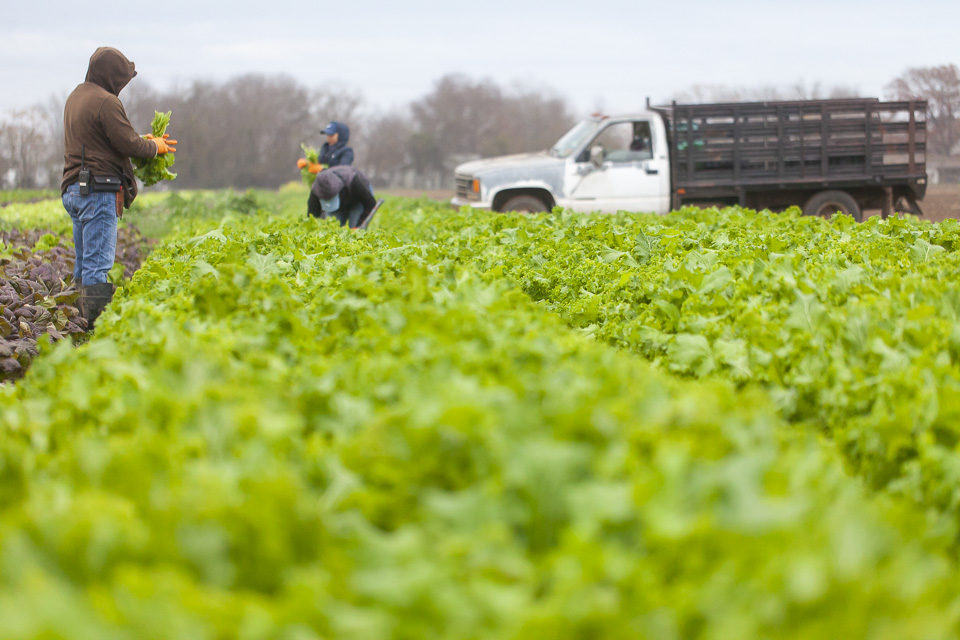 Neon mustard greens. Photo by Scott David Gordon.
Neon mustard greens. Photo by Scott David Gordon.
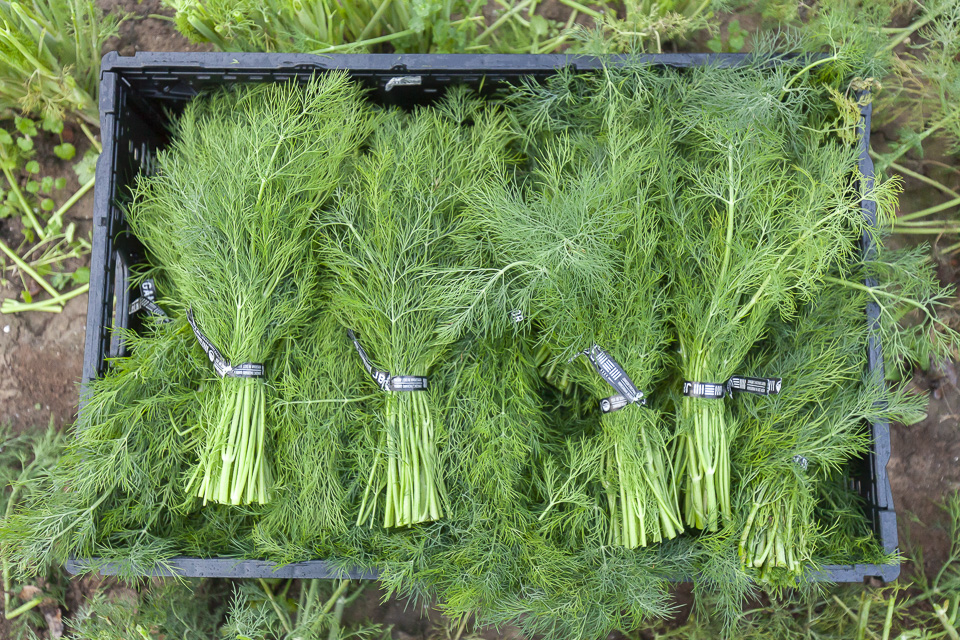 Frilly dill, so tender and fragrant, making any dish it touches a little bit brighter and a little bit fresher. Photo by Scott David Gordon.
Frilly dill, so tender and fragrant, making any dish it touches a little bit brighter and a little bit fresher. Photo by Scott David Gordon.
 When we harvest a herb, we begin on one end of the row and cut as many bunches as the day's orders require. Here, you can see a harvested dill row, and a to-be-harvested dill row. Photo by Scott David Gordon.
When we harvest a herb, we begin on one end of the row and cut as many bunches as the day's orders require. Here, you can see a harvested dill row, and a to-be-harvested dill row. Photo by Scott David Gordon.
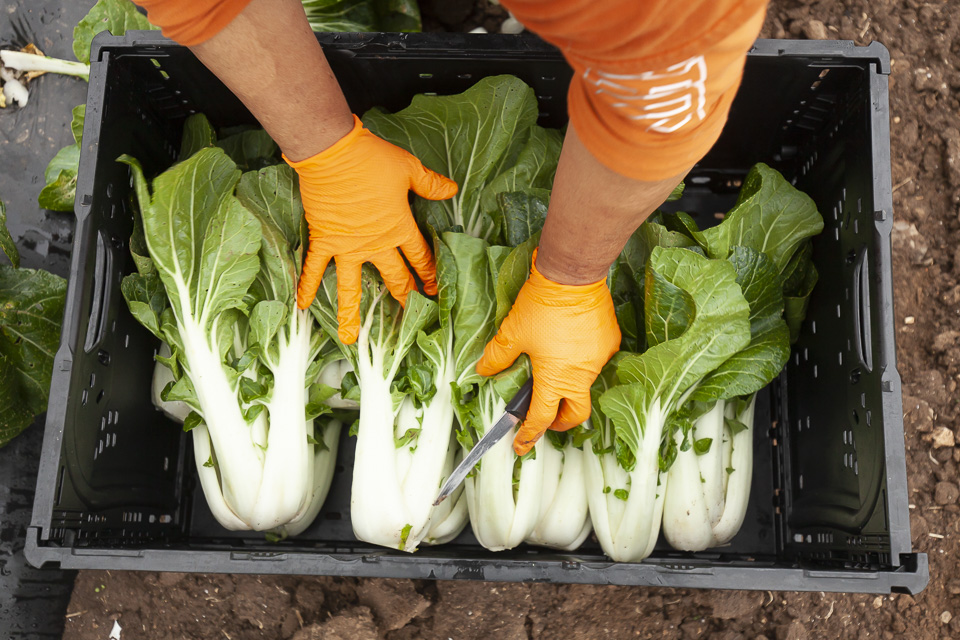 Freshly cut bok choy, bound for market. Photo by Scott David Gordon.
Freshly cut bok choy, bound for market. Photo by Scott David Gordon.
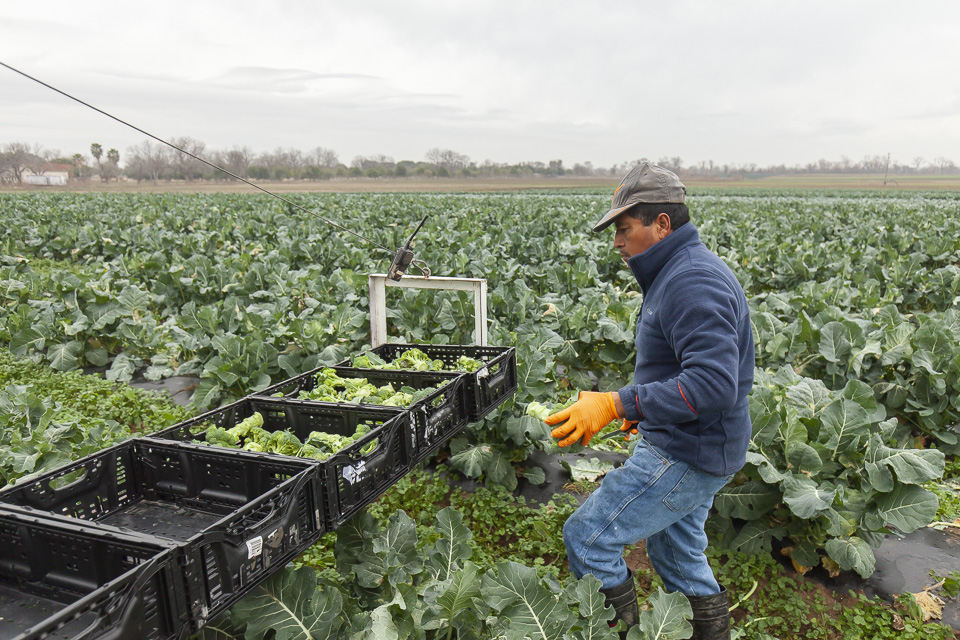 The great broccoli hunt of 2020. Photo by Scott David Gordon.
The great broccoli hunt of 2020. Photo by Scott David Gordon.
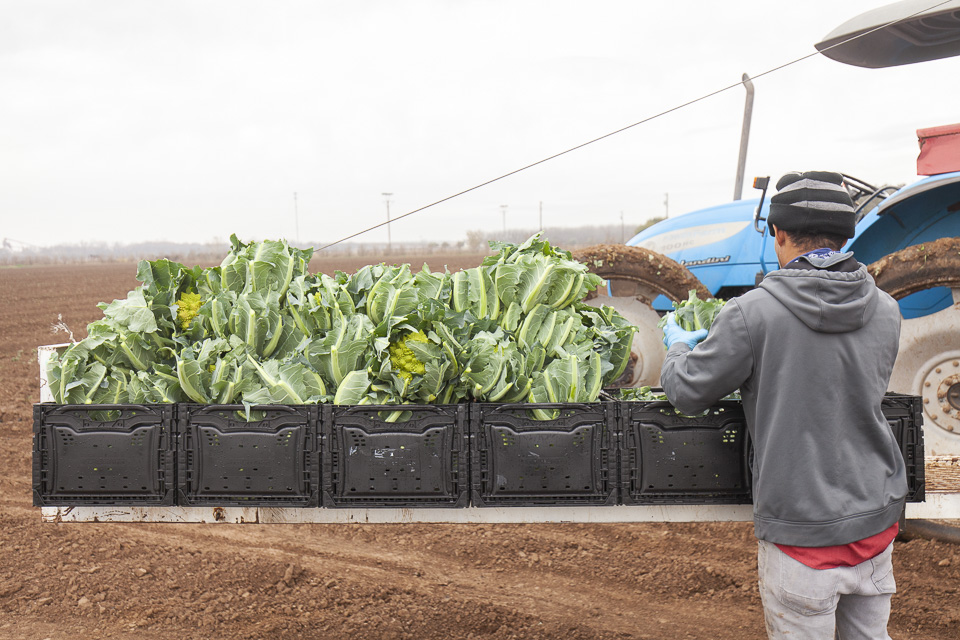 A floating harvest truck arm, strong enough to hold a bounty of romanesco. Photo by Scott David Gordon.
A floating harvest truck arm, strong enough to hold a bounty of romanesco. Photo by Scott David Gordon.
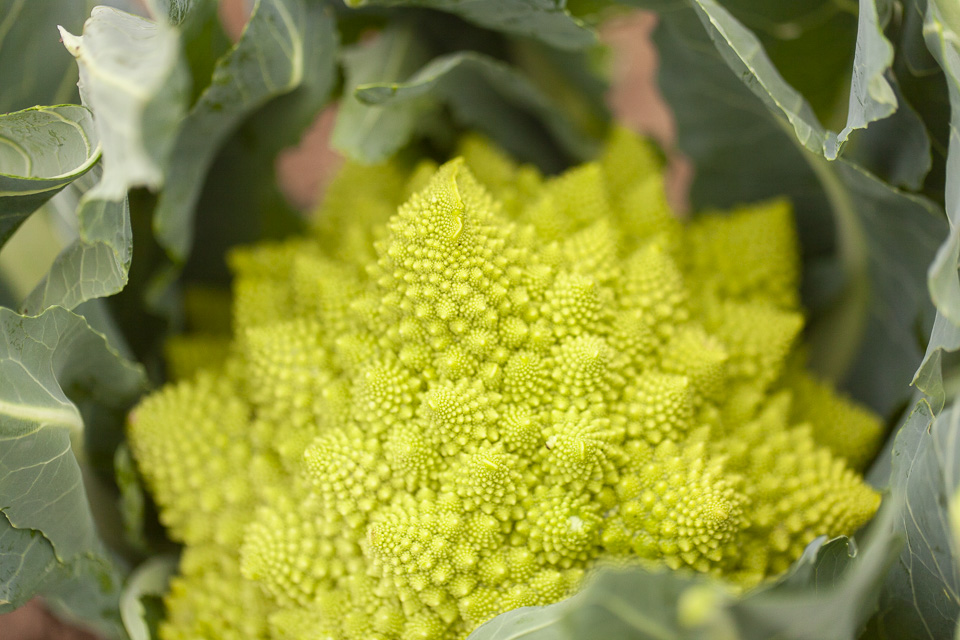 Everyone's favorite brassica is finally here. Photo by Scott David Gordon.
Everyone's favorite brassica is finally here. Photo by Scott David Gordon.CSA BOX CONTENTS WEEK OF JAN 6TH
01/07/20 — Scott
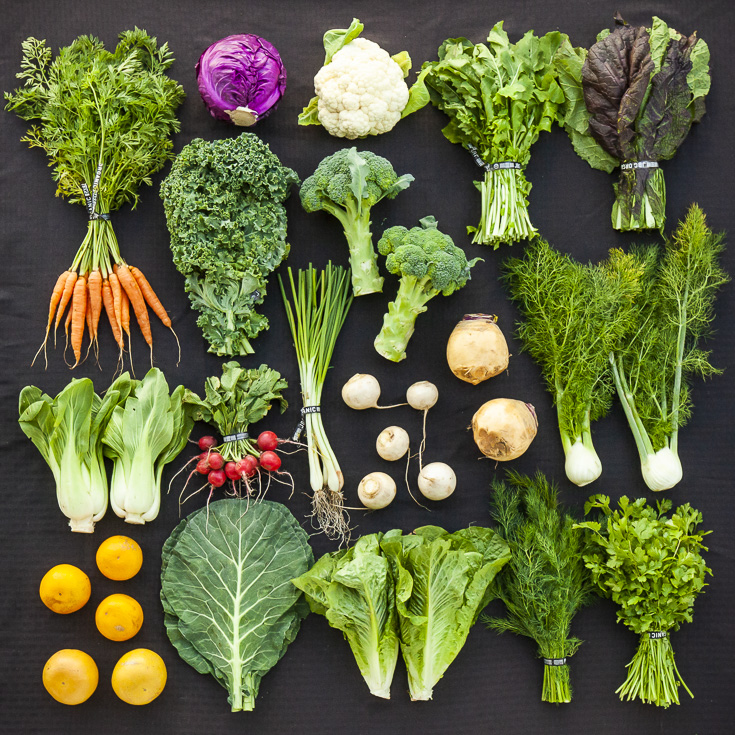 CSA Box Contents Week Of Jan 6th
CSA Box Contents Week Of Jan 6th
Large Box
Bok Choy, Baby
Broccoli X 2
Cabbage, Napa
Carrot, Orange
Cauliflower
Greens, Collards
Greens, Spinach
Herb, Parsley, Flat
Onion, Multiplying
Radish
Turnip, White Japanese
Bok Choy, Baby
Broccoli X 2
Cabbage, Napa
Carrot, Orange
Cauliflower
Greens, Collards
Greens, Spinach
Herb, Parsley, Flat
Onion, Multiplying
Radish
Turnip, White Japanese
Medium Box
Broccoli
Carrot, Orange
Cauliflower
Greens, Arugula
Greens, Kale, Curly
Greens, Mustard
Herb, Parsley, Flat
Onion, Multiplying
Radish
Turnip, White Japanese
Broccoli
Carrot, Orange
Cauliflower
Greens, Arugula
Greens, Kale, Curly
Greens, Mustard
Herb, Parsley, Flat
Onion, Multiplying
Radish
Turnip, White Japanese
Small Box
Broccoli
Carrot, Orange
Cauliflower
Greens, Kale, Curly
Greens, Mustard
Greens, Spinach
Onion, Multiplying
Broccoli
Carrot, Orange
Cauliflower
Greens, Kale, Curly
Greens, Mustard
Greens, Spinach
Onion, Multiplying
Individual Box
Broccoli
Cauliflower
Greens, Arugula
Greens, Collards
Herb, Parsley, Flat
Radish
Broccoli
Cauliflower
Greens, Arugula
Greens, Collards
Herb, Parsley, Flat
Radish
CSA BOX CONTENTS WEEK OF JAN 6TH
01/07/20 — Scott
 CSA Box Contents Week Of Jan 6th
CSA Box Contents Week Of Jan 6th
Large Box
Broccoli
Cabbage, Red
Carrot, Orange
Cauliflower
Greens, Arugula
Greens, Kale, Curly
Herb, Cilantro
Herb, Fennel
Lettuce, Romaine
Onion, Multiplying
Radish, Red
Turnip, Rutabaga
NO MAYO COLESLAW
01/08/20 — Ada Broussard
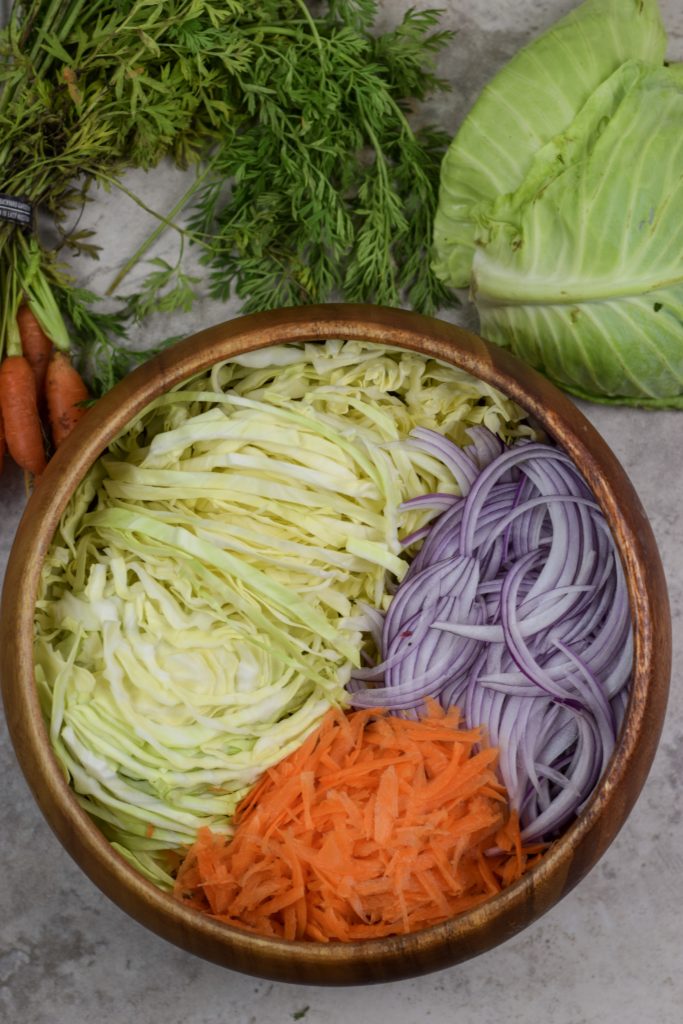
No Mayo Coleslaw
Servings: 4
Total Time: 40 minutes
Author: The Migoni Kitchen
This is a simple coleslaw recipe perfect to pair with fish tacos or pulled pork sandwiches or on its own! We prefer coleslaw with more vinegar than mayo - so this recipe just has a few basic ingredients.
Ingredients:
- 1 Small Head Cabbage, roughly chopped
- 1 Cup Shredded Carrots
- ½ Red Onion, thinly sliced
- 1 Tablespoon Dijon Mustard
- 1 Tablespoon Honey
- ¼ Cup Apple Cider Vinegar
- 2 Tablespoons Olive Oil
- ½ Teaspoon Kosher Salt
- ¼ Teaspoon Black Pepper
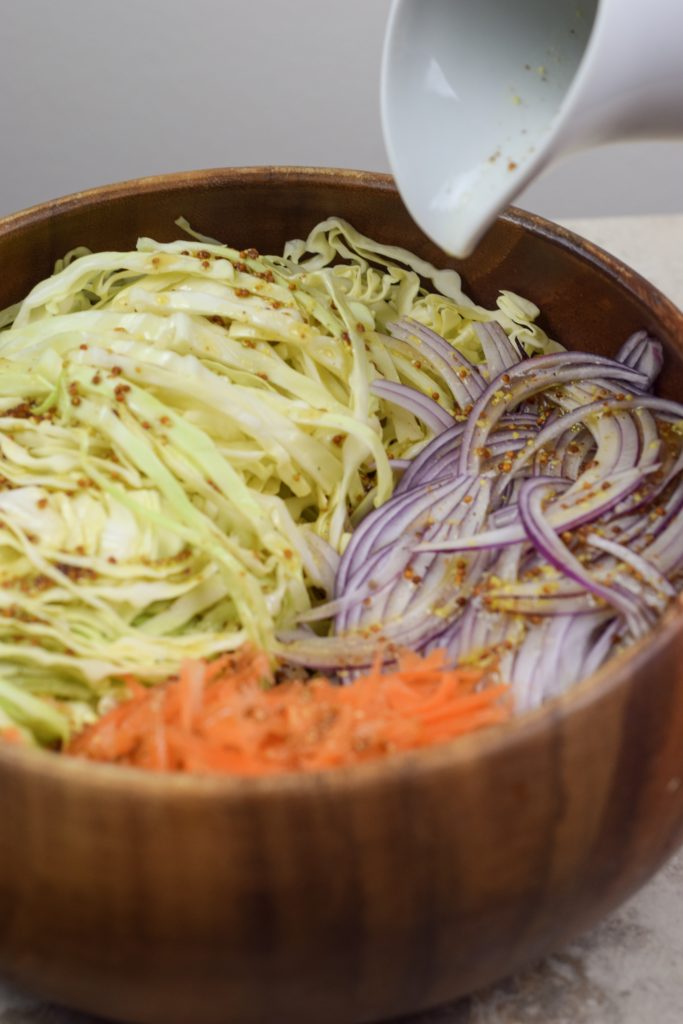
Directions:
- Combine dijon mustard, honey, vinegar, salt, pepper, and oil in a small bowl and whisk to combine.
- Combine the shredded cabbage, carrots, and red onion in a large bowl and toss with the dressing.
- Let sit to marinate for about 30 minutes or can be prepared one day ahead and refrigerated.
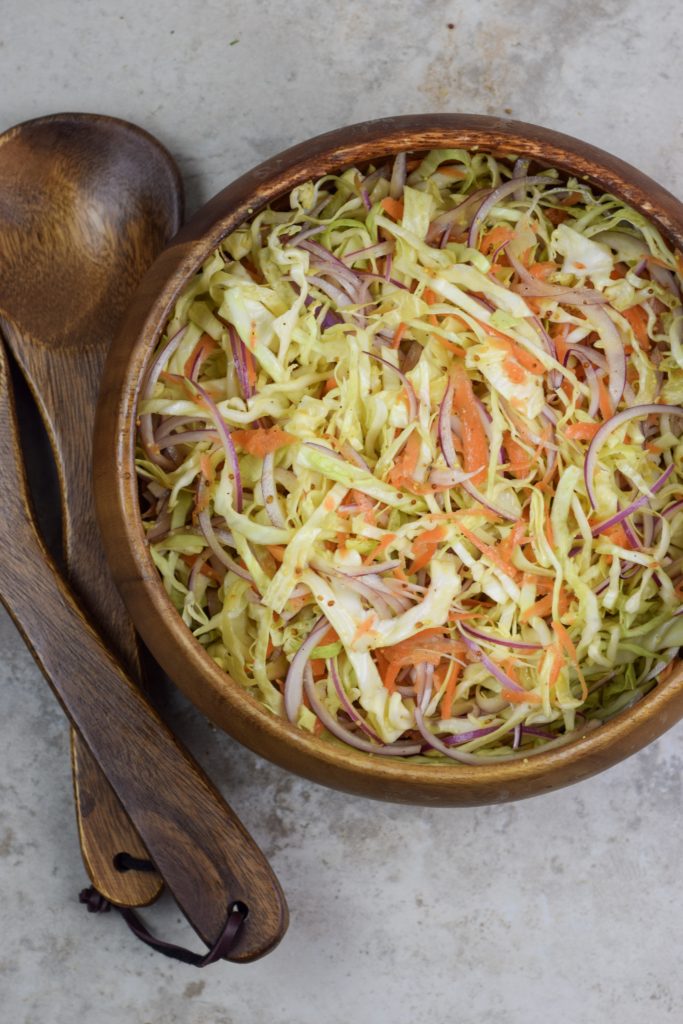
5 RESOLUTIONS THAT ARE EASY, AND DELICIOUS, TO KEEP
01/10/20 — Ada Broussard
Still looking for some resolutions to kick of 2020? We’re all for self-improvement, but strict diets and rigid goals just don’t do the trick for us. Instead, we’ve compiled a list of resolutions that can and should be fun. Resolutions that aren’t too vague nor too far fetched. Resolve to do one, or all of these, and you’ll likely end up eating healthier and maybe even eating happier. We wish you a healthy and energized start to the year.
![]() Martha Pincoffs is the founder of 30 at Home, a challenge to cook all of your meals, for 30 days. Checkout the link below to read the full story about 30 at Home. Photo by Scott David Gordon.
Martha Pincoffs is the founder of 30 at Home, a challenge to cook all of your meals, for 30 days. Checkout the link below to read the full story about 30 at Home. Photo by Scott David Gordon.
![]() Getting a CSA box is a great way to ensure you cook more. These veggies aren't going to slice themselves! Photo by Scott David Gordon.
Getting a CSA box is a great way to ensure you cook more. These veggies aren't going to slice themselves! Photo by Scott David Gordon.
![]() To incorporate more local ingredients into your cooking, head to a farmers' market. Pictured here is the iconic SFC Downtown Farmers' Market, held each Saturday in Republic Square. Photo by Scott David Gordon.
To incorporate more local ingredients into your cooking, head to a farmers' market. Pictured here is the iconic SFC Downtown Farmers' Market, held each Saturday in Republic Square. Photo by Scott David Gordon.
![]() Do you love Indian food but are intimdated to make it? Find Krishna's easy recipe for Aloo Mutter on the JBG blog by searching "aloo mutter" in the search bar. Photo by Scott David Gordon.
Do you love Indian food but are intimdated to make it? Find Krishna's easy recipe for Aloo Mutter on the JBG blog by searching "aloo mutter" in the search bar. Photo by Scott David Gordon.
![]() Using high quality ingredients, like fresh veggies straight from our fields, is the key to cooking simple food, that is delicious. Photo by Scott David Gordon.
Using high quality ingredients, like fresh veggies straight from our fields, is the key to cooking simple food, that is delicious. Photo by Scott David Gordon.
![]() Involve your guests in the cooking process - it will lighten your load and also make everyone feel welcome. Photo by Scott David Gordon.
Involve your guests in the cooking process - it will lighten your load and also make everyone feel welcome. Photo by Scott David Gordon.
Best of luck with these new year’s resolutions. We hope our veggies make their way into some of your meals. Let us know how it goes!
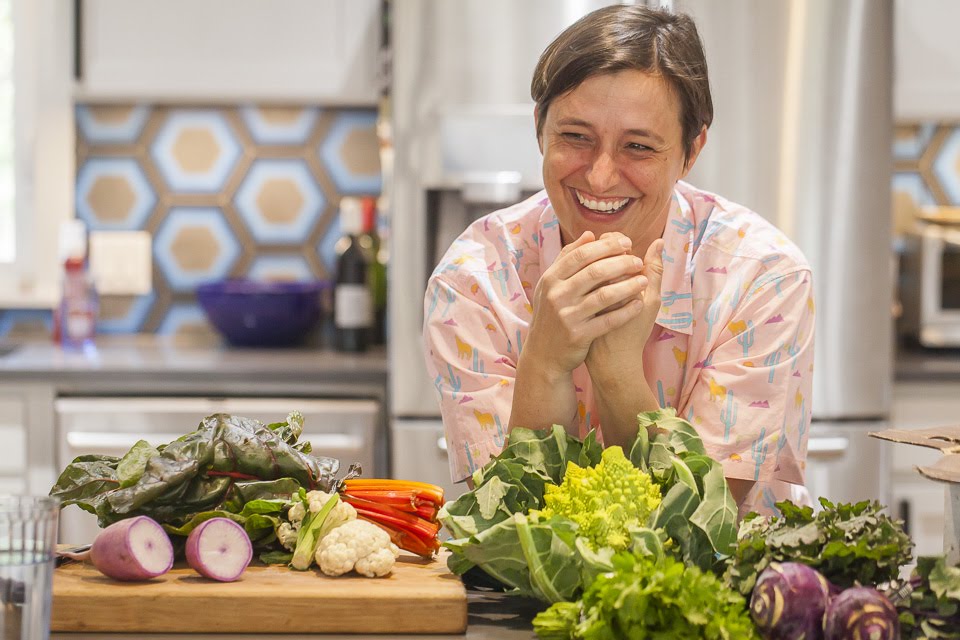 Martha Pincoffs is the founder of 30 at Home, a challenge to cook all of your meals, for 30 days. Checkout the link below to read the full story about 30 at Home. Photo by Scott David Gordon.
Martha Pincoffs is the founder of 30 at Home, a challenge to cook all of your meals, for 30 days. Checkout the link below to read the full story about 30 at Home. Photo by Scott David Gordon.
1. Cook more.
Austin has no lack of delicious eateries, and with so many options for take out and food delivery, it can be tempting to forgo the perfectly good vegetables you have sitting in your fridge and pick something up. Why don’t you resolve to cook more? Maybe you go all in and do the 30 at Home Challenge (we featured this challenge last year - eat all meals at home for 30 days!). Or maybe you resolve to pack your lunch everyday. (Here is a great guide for that very goal.) Or perhaps, save restaurant meals for the weekend.. Whatever the goal is, make sure it fits with your lifestyle and isn’t too extreme. Cooking more has so many benefits - gain new skills, spend more time at home, and save money.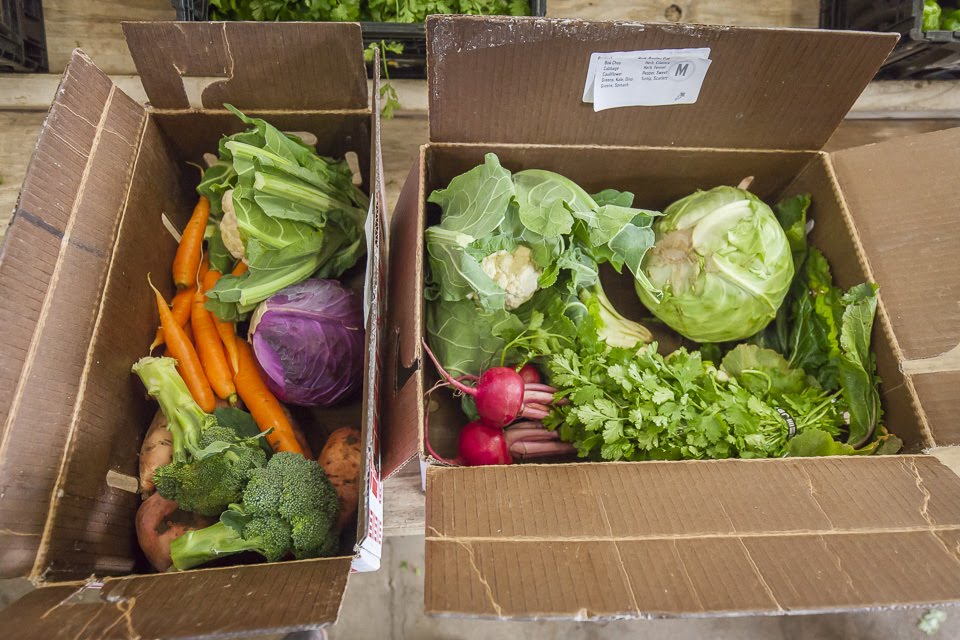 Getting a CSA box is a great way to ensure you cook more. These veggies aren't going to slice themselves! Photo by Scott David Gordon.
Getting a CSA box is a great way to ensure you cook more. These veggies aren't going to slice themselves! Photo by Scott David Gordon.
2. Eat more vegetables.
This may seem a little… obvious… coming from your vegetable farmers, but we think it’s a noble goal, nonetheless. Are you a CSA Member? Resolve to use each and every vegetable in your box, and then some. Considering the CSA? It’s an awesome way to get more vegetables into your diet - we grow them, harvest and deliver the veggies… all you need to do is cook them. (Join before the end of the month, and we’ll send you a free box. Code: freshidea2). We hope a resolve to eat more vegetables means eating more local vegetables. Resolve to have at least one vegetable from a local farmer in each and every dish you cook! Checkout the JBG Recipe Archive for some inspiration, scour the internet, or turn to classic recipe websites like food52 , Epicurious nytimes, and Bon Appetit. Eating more vegetables may mean you eat a little less meat, but instead of focusing on less meat, we encourage you to think about the quality of the meat you consume. Eat meat raised on pasture, ideally coming from a local farm or ranch. There are so many farmers’ markets in town, and most of them offer a wide selection of quality meat (and vegetables). If it’s not the weekend, grocery stores like Wheatsville and Whole Foods, as well as butcher shops like Salt and Time and Dai Due carry Texas products that you can trust.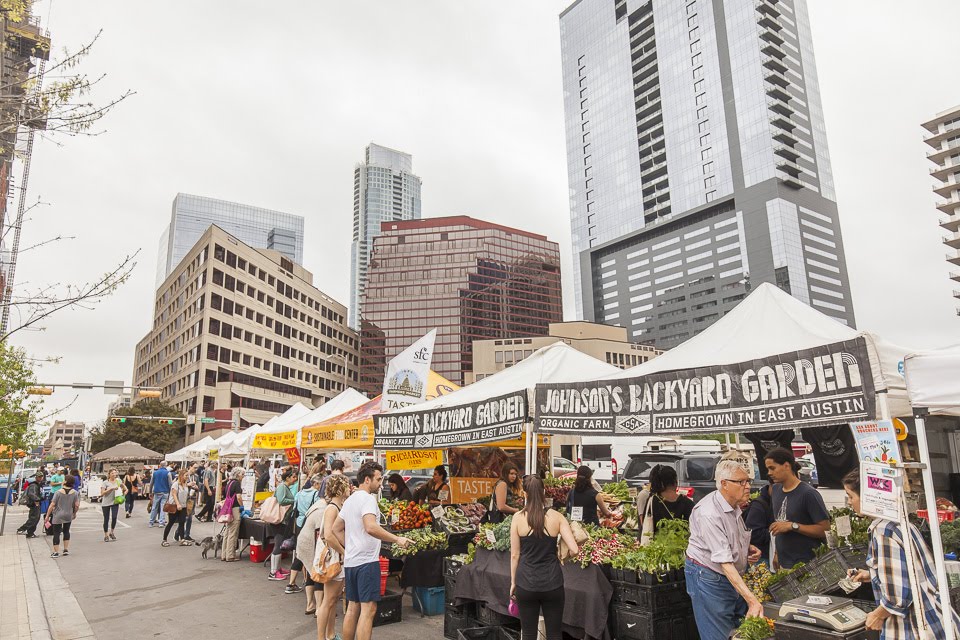 To incorporate more local ingredients into your cooking, head to a farmers' market. Pictured here is the iconic SFC Downtown Farmers' Market, held each Saturday in Republic Square. Photo by Scott David Gordon.
To incorporate more local ingredients into your cooking, head to a farmers' market. Pictured here is the iconic SFC Downtown Farmers' Market, held each Saturday in Republic Square. Photo by Scott David Gordon.
3. Cook something new.
If you’re like us, you have a mental catalog of dishes you’ve always wanted to try and make. This is the year, nay, the month (!) to tackle at least one of those menu items. Set aside some time on the weekend to tackle a kitchen-project - pickle some stuff, make a giant batch of empanadas (and freeze some for later), or try your hand at gnocchi. Do you crave a certain dish from a restaurant in town? Try to recreate it at home! If you usually cook with east Asian flavors, consider traveling to the Italian peninsula. Do you have any trips planned for 2020? Take a moment to research the foodways of that place (even if it’s just somewhere else in the U.S.) and let those flavors inspire you. Head to the bookstore or library and flip through some cookbooks… it’s okay to choose a recipe based on the photo. That’s why they’re there. Do you love Indian food but are intimdated to make it? Find Krishna's easy recipe for Aloo Mutter on the JBG blog by searching "aloo mutter" in the search bar. Photo by Scott David Gordon.
Do you love Indian food but are intimdated to make it? Find Krishna's easy recipe for Aloo Mutter on the JBG blog by searching "aloo mutter" in the search bar. Photo by Scott David Gordon.
4. Cook something super simple.
Give yourself the freedom to eat something as simple as white rice and sauteed greens, for example. Not only will your digestive system thank you (a break after the holidays!), but committing to eating very simply (at least for some meals) will free up some mental and physical time for other things. Eat leftovers, eat simply, maybe just buy some cheese and crackers, slice up a radish and call it dinner. Food doesn’t have to be complicated!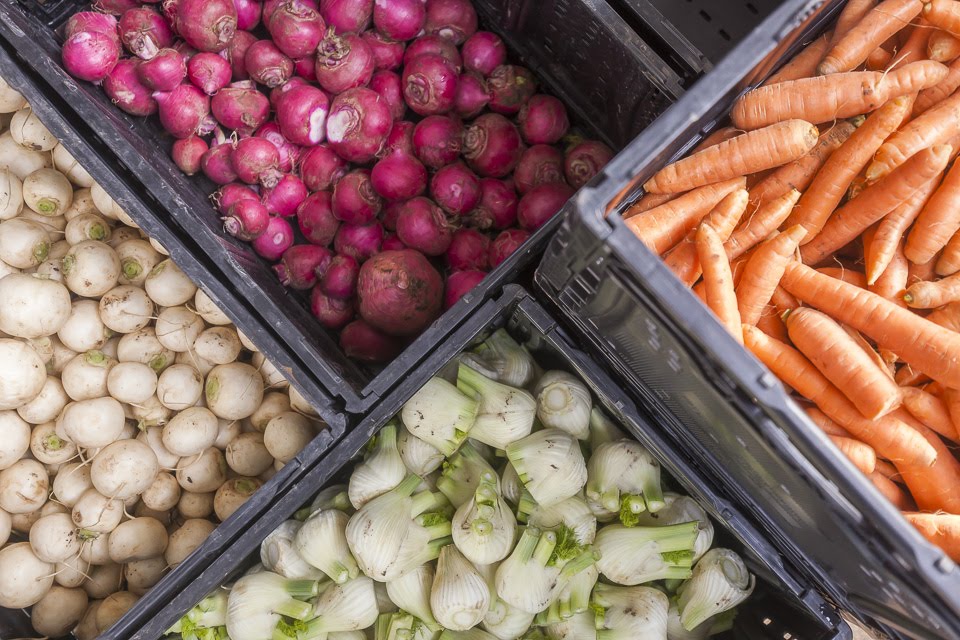 Using high quality ingredients, like fresh veggies straight from our fields, is the key to cooking simple food, that is delicious. Photo by Scott David Gordon.
Using high quality ingredients, like fresh veggies straight from our fields, is the key to cooking simple food, that is delicious. Photo by Scott David Gordon.
5. Invite someone over for dinner.
If you’re not used to hosting or feeding other people, the idea to cook something for someone else can be a little daunting. Will they like it? Will it come out right? Were they expecting something fancier? Though these worries may keep you from doing the deed, don’t let them! Cooking for someone can be super easy. Call it like it is: “Come over for taco Tuesday, and please bring some salsa!” See? That wasn’t too hard. Cooking for someone is a great way to show you care, plus the quality of the time spent together is usually superior than trying to navigate a busy bar line or yell over too-loud music.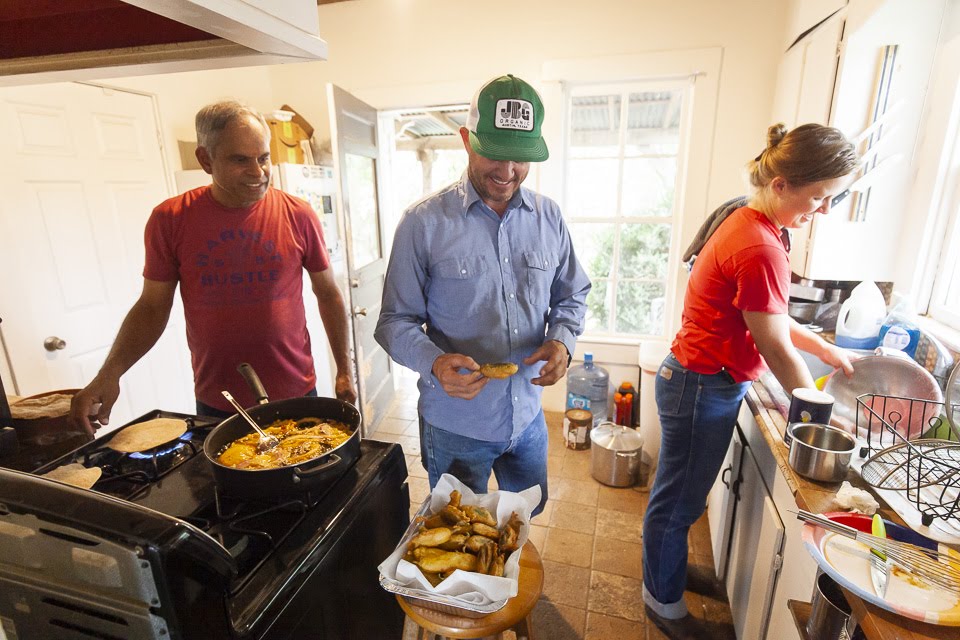 Involve your guests in the cooking process - it will lighten your load and also make everyone feel welcome. Photo by Scott David Gordon.
Involve your guests in the cooking process - it will lighten your load and also make everyone feel welcome. Photo by Scott David Gordon.
Best of luck with these new year’s resolutions. We hope our veggies make their way into some of your meals. Let us know how it goes!
CSA BOX CONTENTS WEEK OF JAN 13TH
01/15/20 — Scott
Large Box
Broccoli
Carrot, Orange
Carrot, Rainbow
Cauliflower
Greens, Arugula
Greens, Kale, Curly
Greens, Mustard
Herb, Cilantro
Onion, Multiplying
Roasting Veggies
Turnip, Rutabaga
Broccoli
Carrot, Orange
Carrot, Rainbow
Cauliflower
Greens, Arugula
Greens, Kale, Curly
Greens, Mustard
Herb, Cilantro
Onion, Multiplying
Roasting Veggies
Turnip, Rutabaga
Medium Box
Broccoli
Carrots
Cauliflower
Greens, Collards
Greens, Kale, Curly
Greens, Spinach
Herb, Cilantro
Onion, Multiplying
Turnip, Rutabaga
Broccoli
Carrots
Cauliflower
Greens, Collards
Greens, Kale, Curly
Greens, Spinach
Herb, Cilantro
Onion, Multiplying
Turnip, Rutabaga
Small Box
Broccoli
Carrots
Cauliflower
Greens, Arugula
Greens, Collards
Herb, Cilantro
Roasting Veggies
Broccoli
Carrots
Cauliflower
Greens, Arugula
Greens, Collards
Herb, Cilantro
Roasting Veggies
Individual Box
Broccoli
Carrots
Cauliflower
Greens, Arugula
Greens, Mustard
Broccoli
Carrots
Cauliflower
Greens, Arugula
Greens, Mustard
CSA BOX CONTENTS WEEK OF JAN 13TH
01/15/20 — Scott
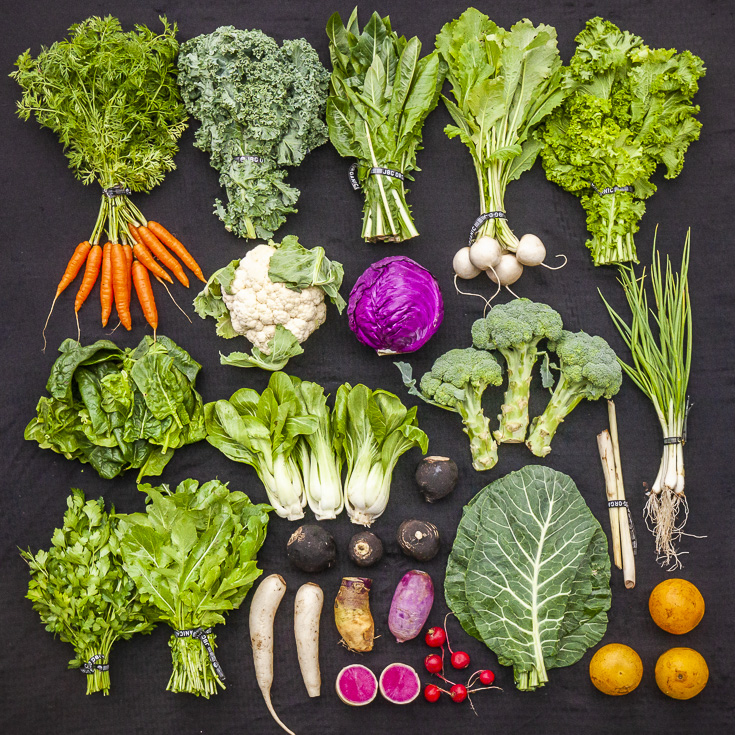 CSA Box Contents Week of Jan 13th
CSA Box Contents Week of Jan 13th
Large Box
Bok Choy, Baby
Broccoli X 2
Cabbage
Carrot, Orange
Cauliflower
Greens, Collards
Greens, Spinach
Herb, Parsley, Flat
Onion, Multiplying
Radish
Turnip, White Japanese
TOP 5 REASONS TO JOIN THE CSA IN 2020
01/17/20 — Ada Broussard
1.SUPPORT LOCAL
By joining our CSA, you are supporting a locally owned and operated business. Buying local helps our economy as well as supply jobs and support the livelihood of fellow Austinites. Unique local businesses are part of what makes Austin and Texas so special! Have you heard of the term food miles? Food miles is the distance food is transported from the time of its production to the time it reaches a consumer’s plate. Food miles are one factor to consider when considering the environmental impact of a particular food. As you can imagine, so many items in your standard grocery store measure food miles in the thousands. When you buy our vegetables, not only are you supporting a local business, but you’re also purchasing food that measures food miles in the tens…. Produce travels from our fields directly to your table, with no grocery store storage warehouses in between.
Our CSA can augment your regular weekly shopping list, ensuring that you have some of that scrumptious local produce in your diet, too! A little goes a long way.
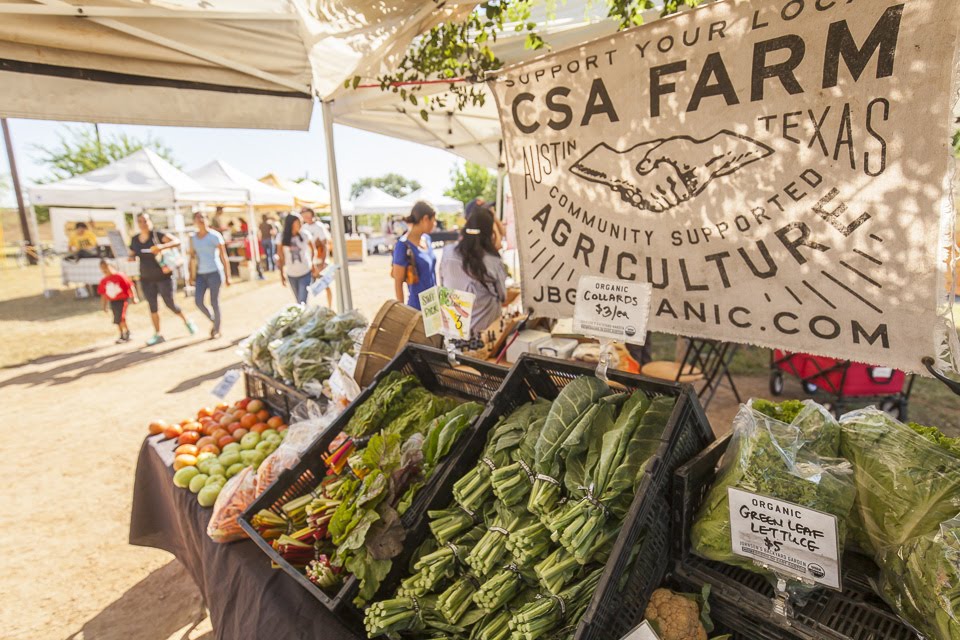 Becoming a member of our local community means getting to know your farmer. Whether you pickup at a market or attend our annual events, it's certainly special to know the people growing your food. Photo by Scott David Gordon.
Becoming a member of our local community means getting to know your farmer. Whether you pickup at a market or attend our annual events, it's certainly special to know the people growing your food. Photo by Scott David Gordon.
2. GOOD FOR YOUR HEALTH
Farm-fresh vegetables are jam packed with vitamins and minerals that are essential to maintaining a healthy lifestyle. Two and a half cups a day says the FDA? Ain’t no thang with a CSA headed your way. Here at JBG, we use sustainable cropping methods that ensure the health of our soil, and healthy soil means nutritious vegetables. In addition to being beautiful (and tasty) this week's kale pesto packs some serious nutritional punch. Photo (and recipe) by Mackenzie Smith. Head to our hope page to find the recipe! Photo by Scott David Gordon.
In addition to being beautiful (and tasty) this week's kale pesto packs some serious nutritional punch. Photo (and recipe) by Mackenzie Smith. Head to our hope page to find the recipe! Photo by Scott David Gordon.
3. FRESHEST POSSIBLE VEGGIES
Cultivated in East Austin and oftentimes harvested no more than a day or two before reaching your doorstep, these vegetables are at peak nutrition and flavor. Getting a CSA share with JBG means you know exactly where your food is coming from and how it's grown. GMO? Heck no! Our farm is certified organic, and then some.Come out for a volunteer day, see your crops in the field, and ask your farmers about it.
 Veggies, like this chard, go from being living plants with roots in the ground to dinner ingredients in a matter of days. Photo by Scott David Gordon.
Veggies, like this chard, go from being living plants with roots in the ground to dinner ingredients in a matter of days. Photo by Scott David Gordon.
4. KNOW YOUR SEASONS
Eating locally connects you to the seasons, to the land, and to your own health and wellness. Cucumbers will cool you down in the summer, while braised collards will warm you up when the temperatures start to drop. Enjoy the best pico de gallo of your life during the short window when cilantro, onions, peppers, and tomatoes all overlap, and we promise you'll never go back to the store-bought stuff again. You'll get acclimated with the seasons on a whole new level, and learn about what naturally grows when and why.
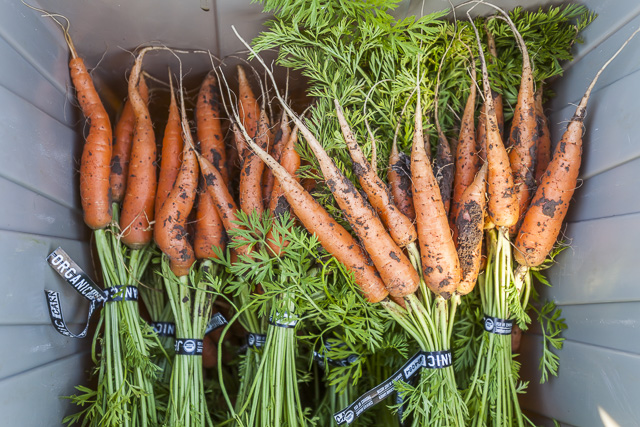 We can grow carrots throughout a large portion of the year, but if you're paying close attention to the seasons you'll notice that carrots harvested after the first big cold snap are as sweet as candy - carbs have converted to sugar as the plant prepares for a cold winter. Or a simmering stew. Photo by Scott David Gordon.
We can grow carrots throughout a large portion of the year, but if you're paying close attention to the seasons you'll notice that carrots harvested after the first big cold snap are as sweet as candy - carbs have converted to sugar as the plant prepares for a cold winter. Or a simmering stew. Photo by Scott David Gordon.
5. TRY NEW FOODS
With farmers who are constantly chompin’ at the bit to try a new crop, who knows what will show up in your CSA box. From the array of Asian greens to the broad pepper spectrum, keep your mind wide open to a whole new world of vegetables you never even knew existed. Each week one of our trusted CSA members creates a recipe that features the CSA box contents, and we’ve got a wonderfully delicious archive of recipes that will help you eat your way through any season.
Still not convinced? If you join by the end of January, we'll send you a free box. Just enter the code below.

PHOTOS FROM THE FARM: 1.17.2020
01/17/20 — Ada Broussard
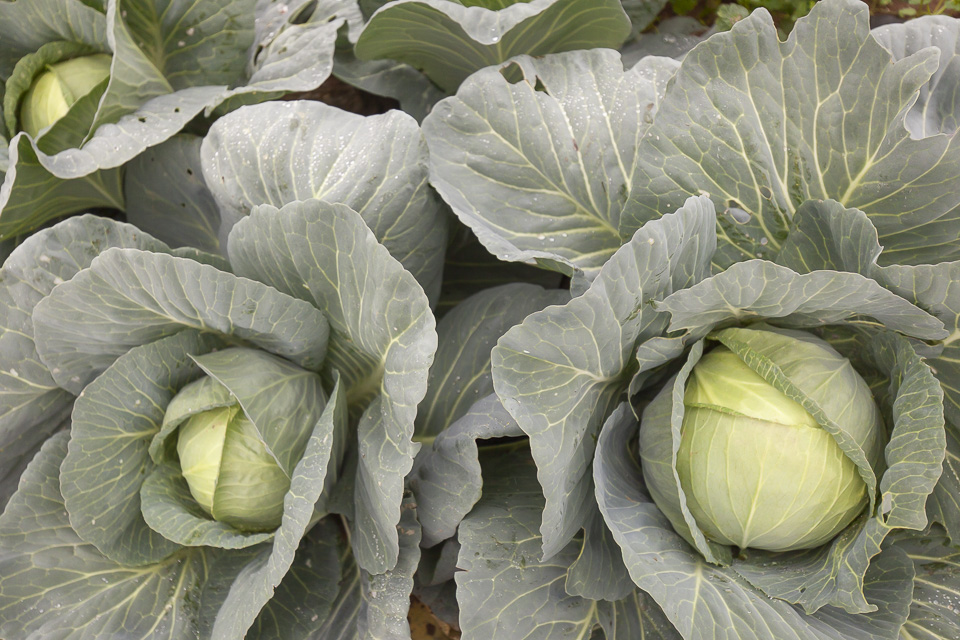 Cabbage is ready to harvest when the center head is very very firm, with the top leaves barely able to be pulled off. Of course, the large outter leaves are edible, too, and those are usually enjoyed by farm staff. Photo by Scott David Gordon.
Cabbage is ready to harvest when the center head is very very firm, with the top leaves barely able to be pulled off. Of course, the large outter leaves are edible, too, and those are usually enjoyed by farm staff. Photo by Scott David Gordon.
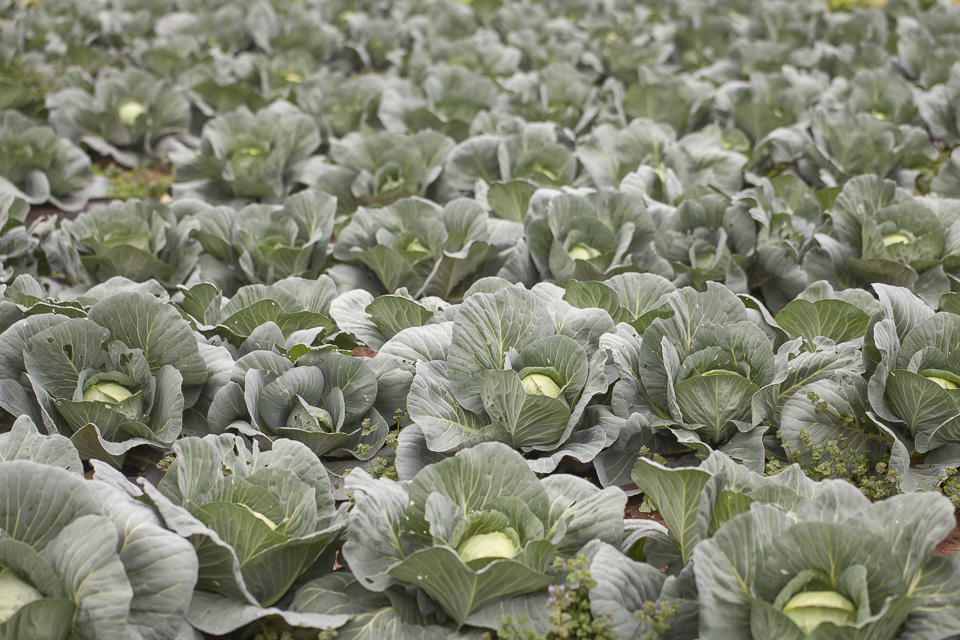 A cabbage patch of Texas proportions. Photo by Scott David Gordon.
A cabbage patch of Texas proportions. Photo by Scott David Gordon.
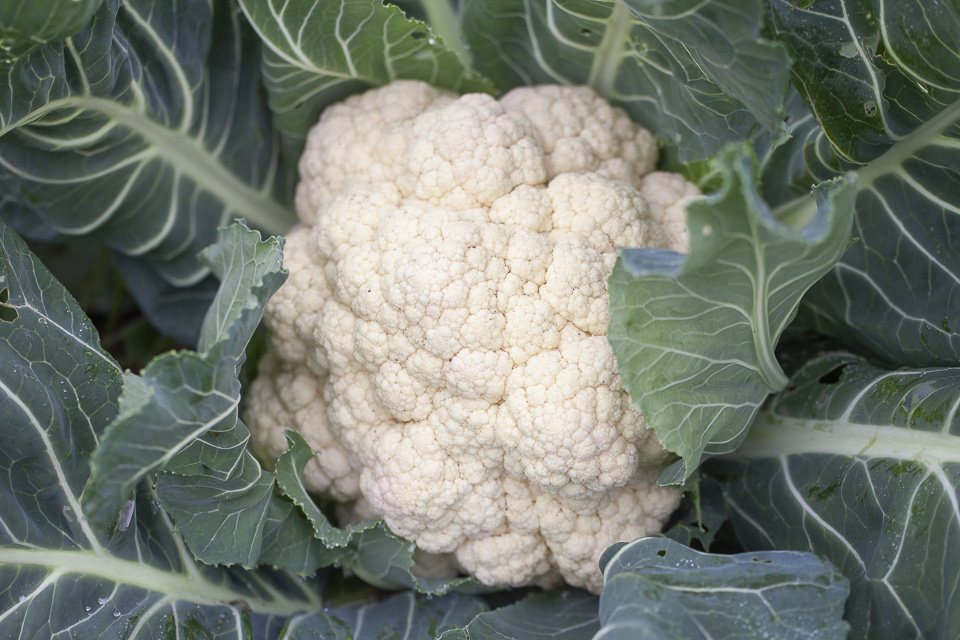 Do you eat your cauliflower stems? These greats are full of nutrition, and the strong center ribs roast up perfectly and are perfect for dipping. Photo by Scott David Gordon.
Do you eat your cauliflower stems? These greats are full of nutrition, and the strong center ribs roast up perfectly and are perfect for dipping. Photo by Scott David Gordon.
 Greens as far as the eye can see. Photo by Scott David Gordon.
Greens as far as the eye can see. Photo by Scott David Gordon.
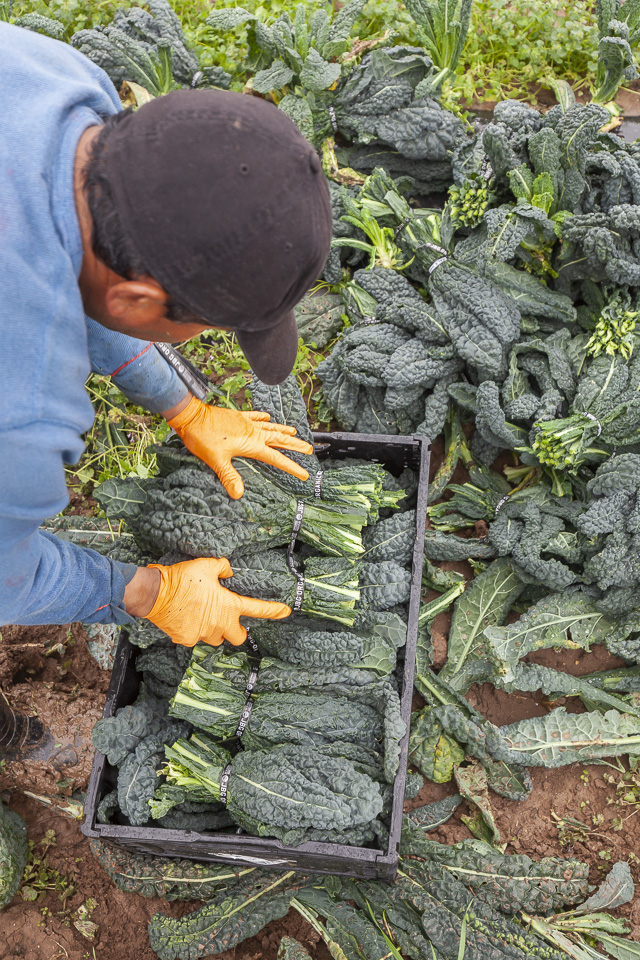 Dino kale, getting read for distribution. Kale leaves that are damaged by bugs (a few holes) or are slightly discolored get thrown on the grown in our kale beds. These decompose, returning both organic matter and nutrients back to the soil. Photo by Scott David Gordon.
Dino kale, getting read for distribution. Kale leaves that are damaged by bugs (a few holes) or are slightly discolored get thrown on the grown in our kale beds. These decompose, returning both organic matter and nutrients back to the soil. Photo by Scott David Gordon.
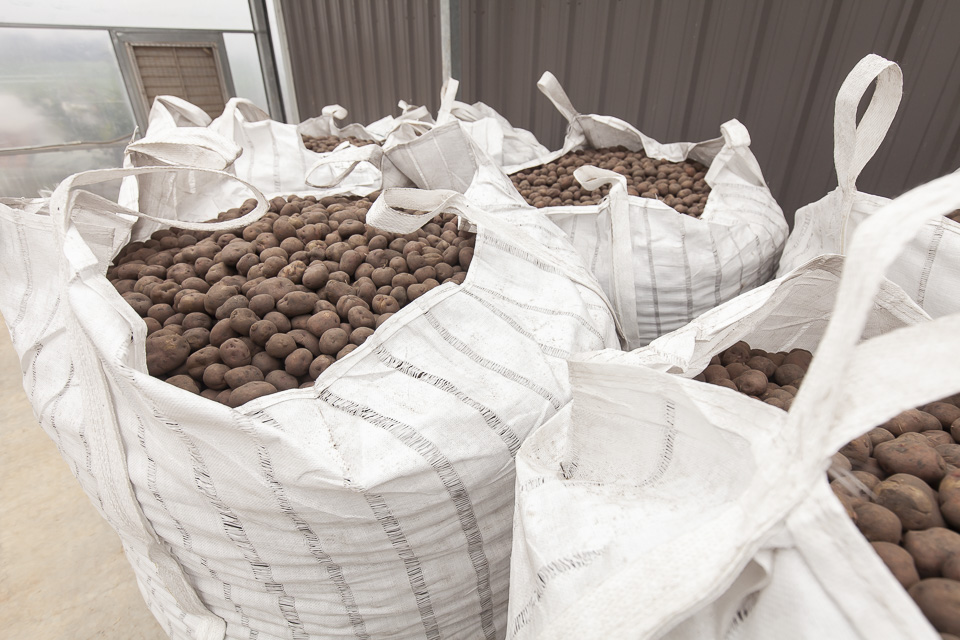 Literal tons of seed potatoes, waiting to be planting. We will also be selling some of these at our Spring Transplant sale (2/29, 3/7, 3/14). Did you mark your calendar? Photo by Scott David Gordon.
Literal tons of seed potatoes, waiting to be planting. We will also be selling some of these at our Spring Transplant sale (2/29, 3/7, 3/14). Did you mark your calendar? Photo by Scott David Gordon.
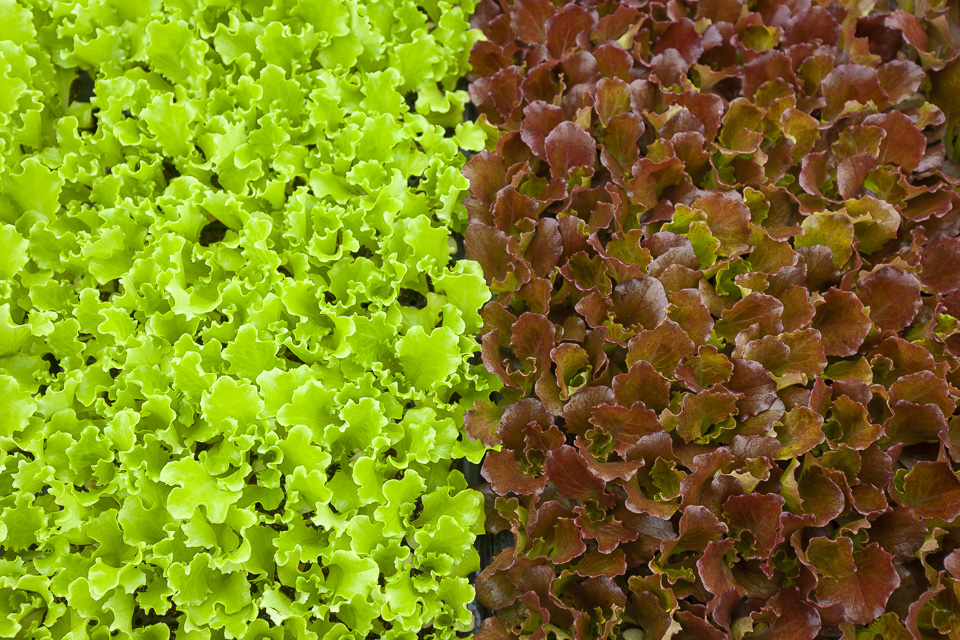 Red and green leaf lettuce. Similar tastes, complementary colors. Photo by Scott David Gordon.
Red and green leaf lettuce. Similar tastes, complementary colors. Photo by Scott David Gordon.
 All this lettuce gets hardened off on a flatbed before it's transported to the fields for planting. Photo by Scott David Gordon.
All this lettuce gets hardened off on a flatbed before it's transported to the fields for planting. Photo by Scott David Gordon.
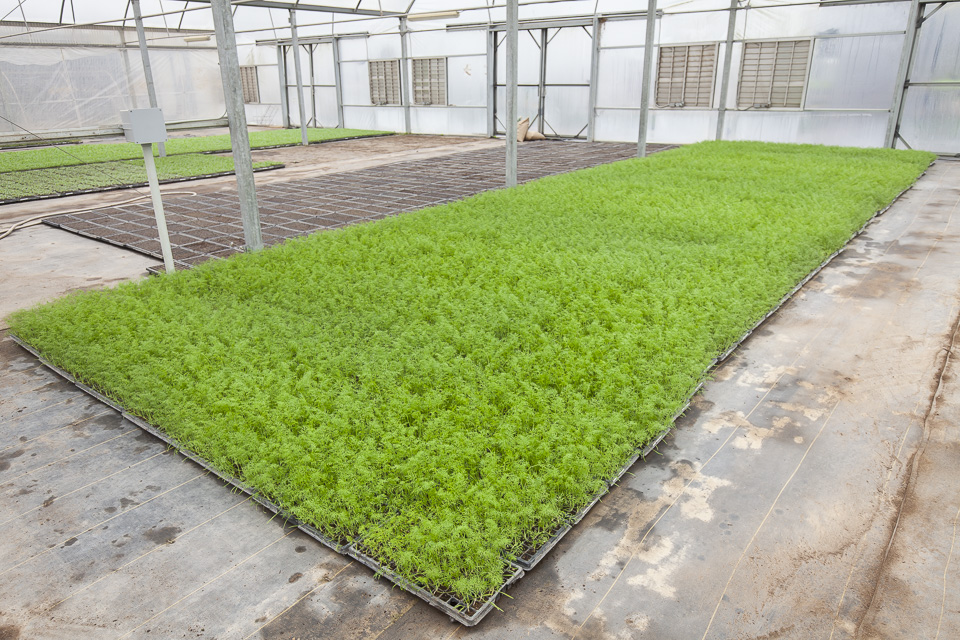 Believe it or not, our greenhouse are starting to fill up with spring crops. It's around the corner! Photo by Scott David Gordon.
Believe it or not, our greenhouse are starting to fill up with spring crops. It's around the corner! Photo by Scott David Gordon.CSA BOX CONTENTS WEEK OF JAN 20TH
01/21/20 — Scott
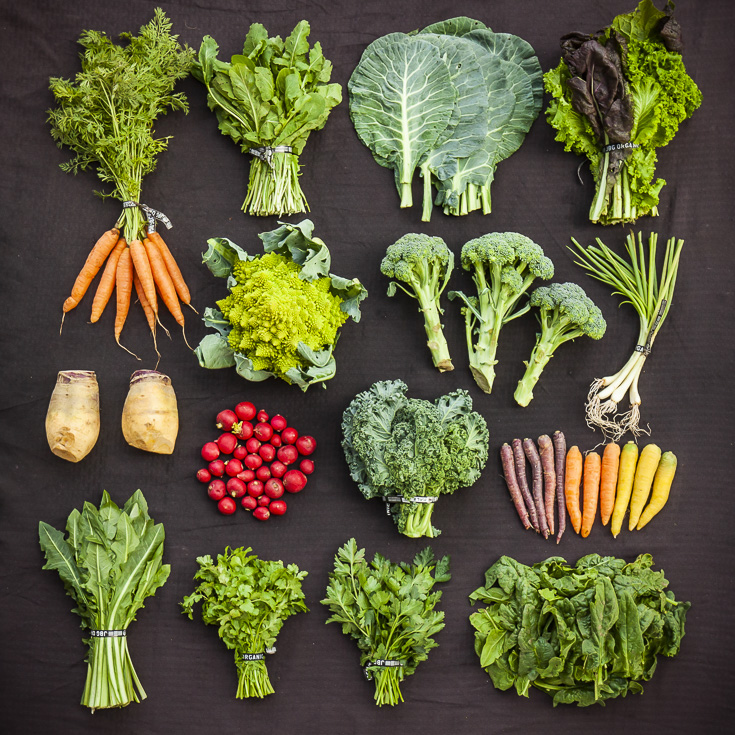 CSA Box Contents Week of Jan 20th
CSA Box Contents Week of Jan 20th
Large Box
Broccoli
Cabbage
Carrots
Citrus, Mixed
Greens, Chard, Rainbow
Greens, Kale, Dino
Herb, Cilantro
Lettuce, Romaine
Onion, Multiplying
Roasting Veggies
Turnip, Scarlett
Broccoli
Cabbage
Carrots
Citrus, Mixed
Greens, Chard, Rainbow
Greens, Kale, Dino
Herb, Cilantro
Lettuce, Romaine
Onion, Multiplying
Roasting Veggies
Turnip, Scarlett
Medium Box
Broccoli
Cabbage
Carrots
Greens, Chard, Rainbow
Greens, Kale, Dino
Herb, Cilantro
Lettuce, Romaine
Onion, Multiplying
Roasting Veggies
Turnip, Scarlett
Broccoli
Cabbage
Carrots
Greens, Chard, Rainbow
Greens, Kale, Dino
Herb, Cilantro
Lettuce, Romaine
Onion, Multiplying
Roasting Veggies
Turnip, Scarlett
Small Box
Broccoli
Cabbage
Carrots
Greens, Arugula
Greens, Kale, Dino
Herb, Parsley, Flat
Onion, Multiplying
Turnip, Scarlett
Broccoli
Cabbage
Carrots
Greens, Arugula
Greens, Kale, Dino
Herb, Parsley, Flat
Onion, Multiplying
Turnip, Scarlett
Individual Box
Broccoli
Cabbage
Carrots
Greens, Kale, Dino
Greens, Spinach
Broccoli
Cabbage
Carrots
Greens, Kale, Dino
Greens, Spinach
CSA BOX CONTENTS WEEK OF JAN 20TH
01/21/20 — Scott
 CSA Box Contents Week of Jan 20th
CSA Box Contents Week of Jan 20th
Large Box
Broccoli
Carrot, Orange
Carrot, Rainbow
Cauliflower
Greens, Arugula
Greens, Kale, Curly
Greens, Mustard
Herb, Cilantro
Onion, Multiplying
Roasting Veggies
Turnip, Rutabaga
ROMANESCO FLORET SALAD
01/23/20 — Ada Broussard
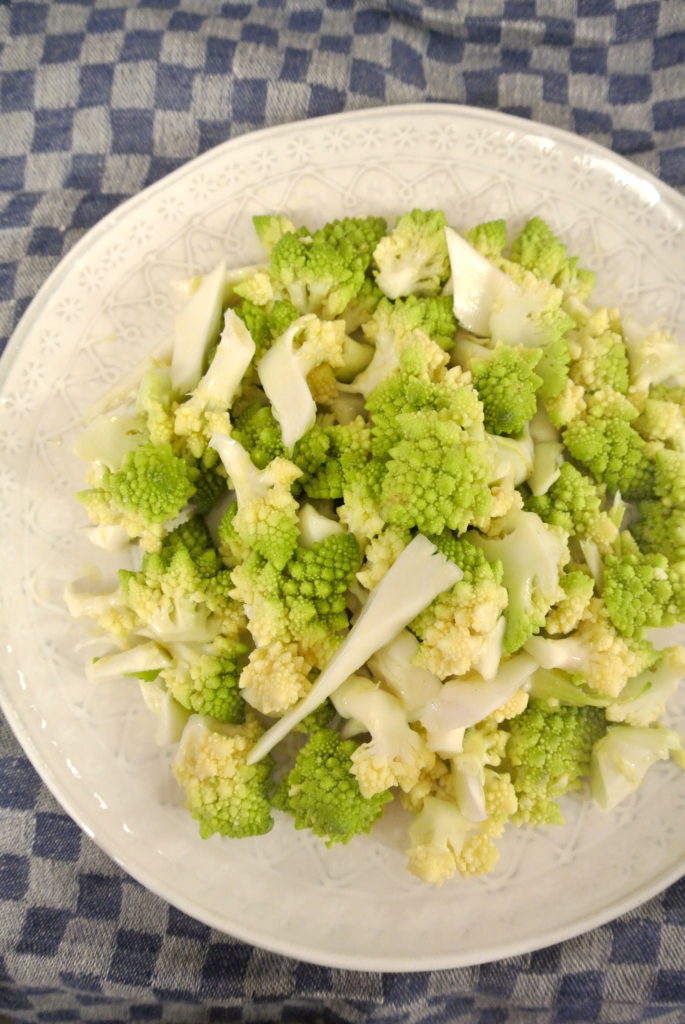
Recipe and Photo by Isaac Winburne and Heydon Hatcher
We made the first iteration of this salad for a dear friend a couple of weeks ago. She gushed about it, I posted a quick shot of the dish on my Instagram, and I received a deluge of responses inquiring about what exactly this stunning, fractal alien vegetable was. Since working at the farm, I’ve always thought of the Romanesco cauliflower as Mother Earth’s veggie crown jewel. Much like a rare gem, having access to this brassica while it’s thriving is difficult to boot, since most grocery stores don’t consistently carry this spiraling enchantress. Thus, I feel immensely grateful to the farmers at JBG for cultivating and harvesting this specific crop year after year for us, and equally ecstatic when I see it gracing the market stand.
The beauty of it is at times unbelievable; thus, retaining its bewitching shape for a dish is usually of utmost importance at our house. This recipe is simple as can be, focuses on the unbridled taste + look of the Romanesco, and is dazzling as a side to any meal.
Ingredients
- One head of Romanesco cauliflower (leafy bottom removed)
- Two lemons
- Olive oil
- Salt
Recipe
Lightly shave small heads off of Romanesco and into small bite-size chunks. Make sure to retain beautiful fractals.
After you have removed all heads and cut into bite-sized pieces, keep the stalk! Cut the stalk in half, and then into slanted chunks. The stalk is surprisingly sweet and different in texture from the heads.
Add one hefty drizzle of extra virgin olive oil and stir around from bottom. Repeat this step once more. Stirring from the bottom is important -- so as not to ruin the shapes.
Add 16 grinds of salt and the juice of two lemons. Stir thoroughly. Enjoy!
CSA SECRETS FROM THE PROS
01/24/20 — Ada Broussard
We've been collecting secrets.... from our CSA Members. And not just any members - those men and women who are true JBG Community Supported Agriculture veterans: folks who have been members of our CSA program for 10+ years. Families who have been opening up, washing, and prepping pounds and pounds of our vegetables for over a decade. In fact, most of these folks have likely cooked and consumed, sliced and sauted, anywhere from 5,000-10,000 pounds of vegetables. Pretty wild, no?
We know that incorporating seasonal vegetables into your weekly menus isn't always the most intuitive process, but as some of these secrets reveal, it can be done. In fact, as these veterans demonstrate, it's quite possible to seamlessly involve local, organic, and seasonal vegetables into your everyday life in a long-term and meaningful way. If you're new to the CSA, we hope these veterans inspire you. With practice, unpacking, storing, and using up each and every vegetable we send you can be as easy as ordering takeout.
Whether you're new to the CSA, have been around for over a year, or are one of our members who have been around since the Holly Street days, we thank you for your support. We hope that by sharing some of these secrets, you'll feel inspired to think of JBG as your eternal grocery store, there to plant, grow, and care for the food that will fuel you into the future.
![]() Give yourself a pat on the back if you've been a member for some time now. Cooking hundreds of pounds of local vegetables is a commendable feat! Photo by Scott.
Give yourself a pat on the back if you've been a member for some time now. Cooking hundreds of pounds of local vegetables is a commendable feat! Photo by Scott.
Risa is right. Give our customization feature a try. We did this just for you! When you customize, you have the ability to swap out two items from your box with two items from our swap list - which is made up of the crops that are most bountiful in any given week. If you're unsure of when your customization window is, just shoot Faith an email (farm@jbgorganic.com) and she'll let you know! And yep, grapefruits will be gone before you know it. You can learn more about customization here, or order grapefruit by the 10 lb. bag here.
![]() Risa's dried herbs. Drying your JBG herbs is a homemade way of season extension. Bravo, Risa! Thank you for the photo!!
Risa's dried herbs. Drying your JBG herbs is a homemade way of season extension. Bravo, Risa! Thank you for the photo!!
What she said. Prep those boxes. Here is a post where we cover some of that, plus tried and true storage tips.
Did someone say turnips?
![]() Turnip gratin. Recipe and photo by Nadia Tamby.
Turnip gratin. Recipe and photo by Nadia Tamby.
My only other thought is, if the box is particularly abundant, stay home and eat it! Fewer restaurants and more home-cooked meals. The two of us get through a medium box nearly every week, with friends over for dinner usually one night a week, but we only eat out on special occasions.
Marian said it all. Here are some other hacks and ideas, like Marian's ingenious bowl of marinated peppers, that will help you use up your veggies throughout the week. And need some more inspiration to stay home and eat? Here are 10 reasons why home cooked meals (with our veggies) are better than a night out.
![]() Too many vegetables in the fridge? Stay home and eat 'em. Photo by Heydon Hatcher.
Too many vegetables in the fridge? Stay home and eat 'em. Photo by Heydon Hatcher.
When in doubt, make a soup.
![]() This chicken soup recipe on our blog is so versatile. Want to make a winter version? Search the blog for "Isaac's Famous Soup". Recipe and photo by Heydon and Isaac Hatcher.
This chicken soup recipe on our blog is so versatile. Want to make a winter version? Search the blog for "Isaac's Famous Soup". Recipe and photo by Heydon and Isaac Hatcher.
My sister remarked “these greens (kale, lettuce, collards, etc) look fresher than in the grocery store!!!!!” I was so proud. We are eating at home more than ever, and feel we are really on the right track nutritionally.
Yes! Mary Ellen has revealed the secret of "refreshing" your greens. More on that here.
Do you have any CSA secrets? We'd love to know.
![]() Is purple daikon a new vegetable to you? Follow Abby's advice and give it a try 3 times before hitting that swap button. It just might be your favorite new radish. Photo by Scott.
Is purple daikon a new vegetable to you? Follow Abby's advice and give it a try 3 times before hitting that swap button. It just might be your favorite new radish. Photo by Scott.
We know that incorporating seasonal vegetables into your weekly menus isn't always the most intuitive process, but as some of these secrets reveal, it can be done. In fact, as these veterans demonstrate, it's quite possible to seamlessly involve local, organic, and seasonal vegetables into your everyday life in a long-term and meaningful way. If you're new to the CSA, we hope these veterans inspire you. With practice, unpacking, storing, and using up each and every vegetable we send you can be as easy as ordering takeout.
Whether you're new to the CSA, have been around for over a year, or are one of our members who have been around since the Holly Street days, we thank you for your support. We hope that by sharing some of these secrets, you'll feel inspired to think of JBG as your eternal grocery store, there to plant, grow, and care for the food that will fuel you into the future.
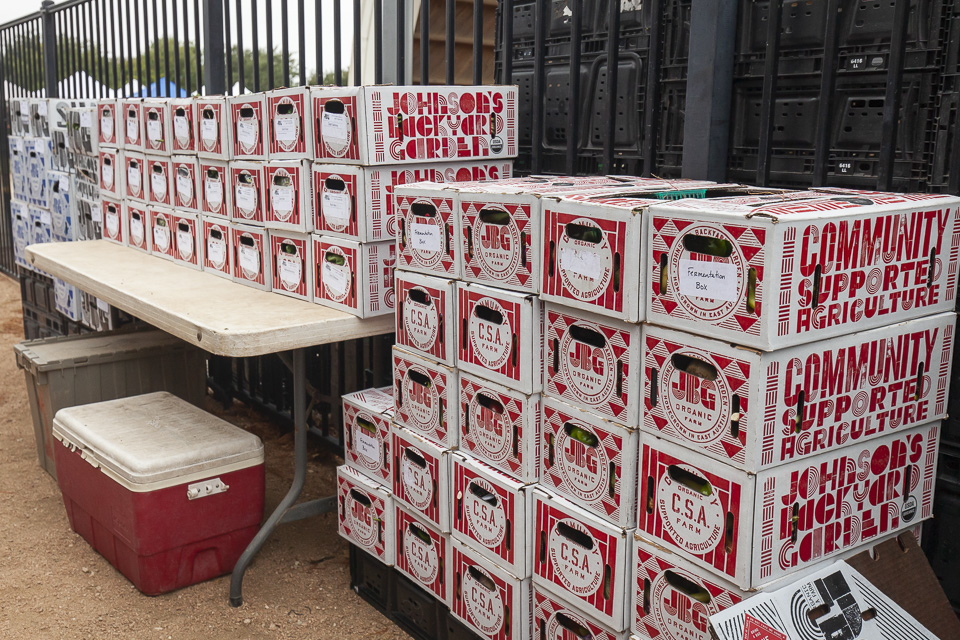 Give yourself a pat on the back if you've been a member for some time now. Cooking hundreds of pounds of local vegetables is a commendable feat! Photo by Scott.
Give yourself a pat on the back if you've been a member for some time now. Cooking hundreds of pounds of local vegetables is a commendable feat! Photo by Scott.
Risa G.
My word of wisdom is utilizing the customization JBG offers. You just need to set a reminder before the window closes :). Also, don't be afraid of trying new veggies, it's always great to try new recipes. One thing I started doing with herbs is to dry them and store them in a glass jar! They still smell really fresh even after being dried! Also the grapefruits. Enjoy the sweetest juiciest grapefruits during the season!Risa is right. Give our customization feature a try. We did this just for you! When you customize, you have the ability to swap out two items from your box with two items from our swap list - which is made up of the crops that are most bountiful in any given week. If you're unsure of when your customization window is, just shoot Faith an email (farm@jbgorganic.com) and she'll let you know! And yep, grapefruits will be gone before you know it. You can learn more about customization here, or order grapefruit by the 10 lb. bag here.
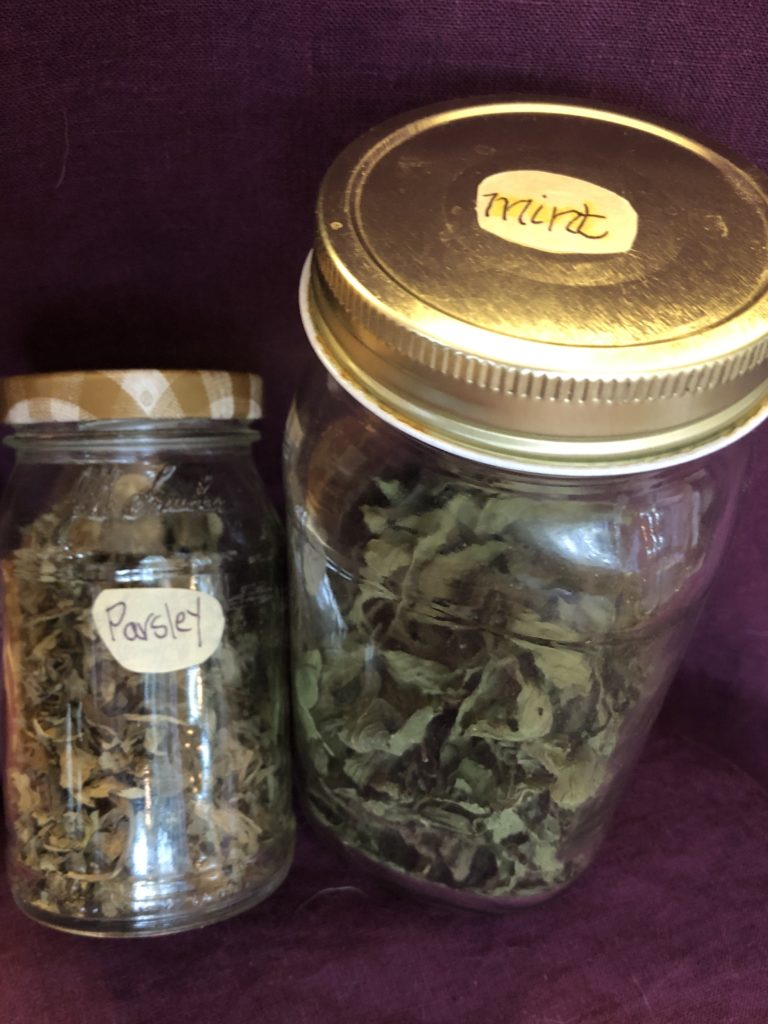 Risa's dried herbs. Drying your JBG herbs is a homemade way of season extension. Bravo, Risa! Thank you for the photo!!
Risa's dried herbs. Drying your JBG herbs is a homemade way of season extension. Bravo, Risa! Thank you for the photo!!
Marcus and Tracie G.
I love the weekly emails from the farm and recipes. We have a few pieces of advice:- Use a recipe app (we use cheftap) to hold on to great recipes to use when you find yourself with an abundance of something
- Have a default easy way to clear out a lot of veggies if needed. Our favorites are roasted root veggies and kale chips.
- Try out the recipes from JBG. We've really liked that those coordinate with the veggies.
Erin O.
As far as advice goes, I try to prep the veggies in advance to ensure I'll use them all before the next week's box. The ability to customize the contents is key for getting veggies the whole family will enjoy.What she said. Prep those boxes. Here is a post where we cover some of that, plus tried and true storage tips.
Jess and Jon K.
One thing I would say is take a look at what's in your box before you pick it up. Customize it! If you have lots of something left from last week and more is coming this week--swap it for something. Do a little planning to fit your veggies into your week. Know what your family likes but don't be scared to try one new thing a week! Roasted turnips have become a favorite around my house!Did someone say turnips?
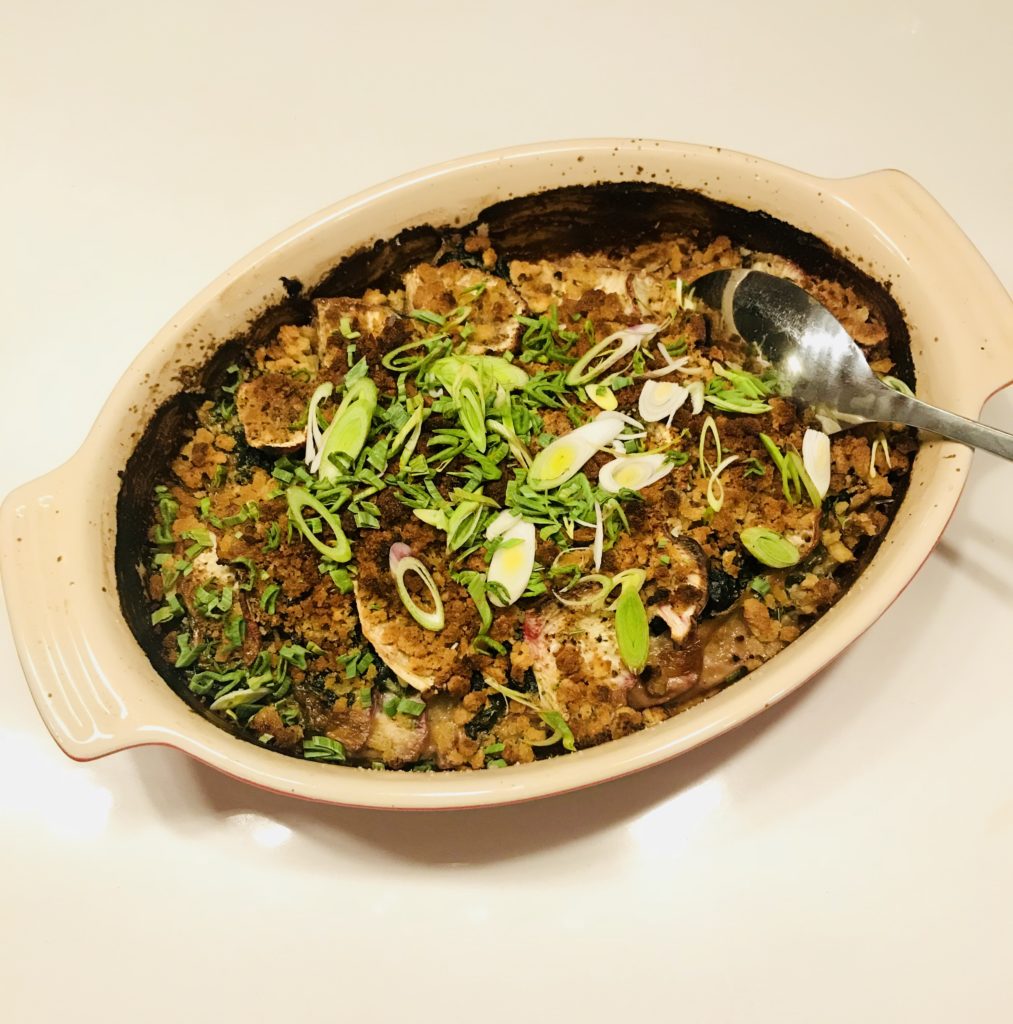 Turnip gratin. Recipe and photo by Nadia Tamby.
Turnip gratin. Recipe and photo by Nadia Tamby.
Marian S.
One piece of advice I can give for people trying to figure out how to use their whole box--is to think outside the box. Use the abundance that you can't find a place for at dinner to replace your go-to dishes that you make as a matter of course. For instance, most of the year, I have to buy lettuce at the store for our evening salad, but many of the box items make excellent salads that are outside my usual playbook. Recently I made a warm cauliflower salad, adding some chopped parsley and a handful of black olives with the vinaigrette. Or in the summer, when we often get a lot of peppers, I'll gently saute them in olive oil with garlic, add about a quarter as many (even canned) tomatoes, and, at the end, parsley or basil. I keep that bowl of scrumptious peppers in the fridge to eat as an extra side dish with, say, broiled chicken, or with eggs, or with white beans, or on bruschetta. They're very versatile and quite addictive--even cold. This is especially good for the peppers we usually get in the box, which can be too delicate to broil or grill.My only other thought is, if the box is particularly abundant, stay home and eat it! Fewer restaurants and more home-cooked meals. The two of us get through a medium box nearly every week, with friends over for dinner usually one night a week, but we only eat out on special occasions.
Marian said it all. Here are some other hacks and ideas, like Marian's ingenious bowl of marinated peppers, that will help you use up your veggies throughout the week. And need some more inspiration to stay home and eat? Here are 10 reasons why home cooked meals (with our veggies) are better than a night out.
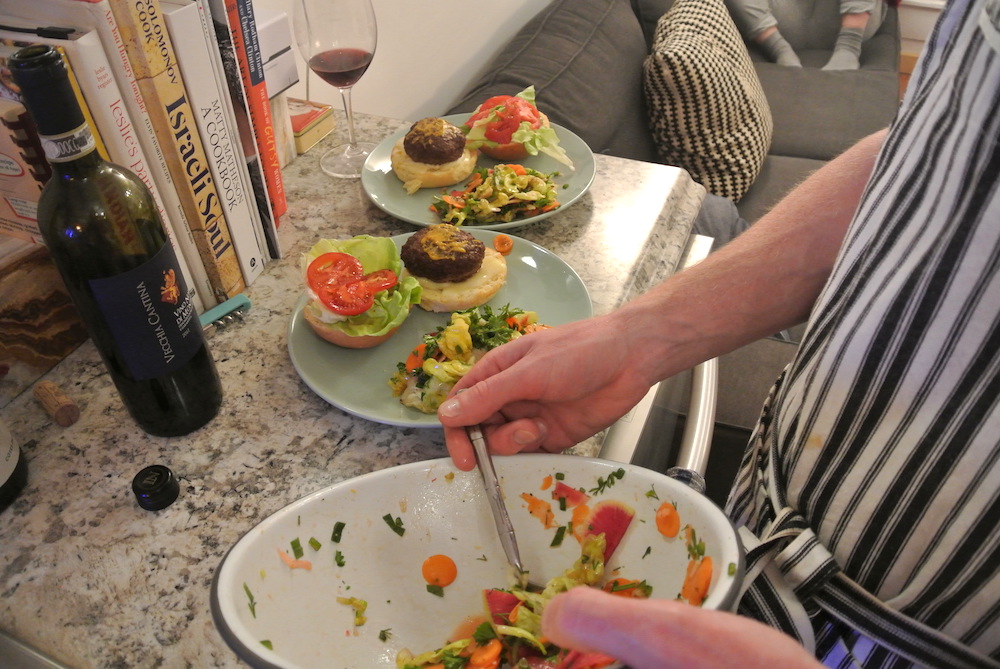 Too many vegetables in the fridge? Stay home and eat 'em. Photo by Heydon Hatcher.
Too many vegetables in the fridge? Stay home and eat 'em. Photo by Heydon Hatcher.
Alana M.
Over the years I’ve made lots of greens soup to empty my crisper drawer for a new share boxWhen in doubt, make a soup.
 This chicken soup recipe on our blog is so versatile. Want to make a winter version? Search the blog for "Isaac's Famous Soup". Recipe and photo by Heydon and Isaac Hatcher.
This chicken soup recipe on our blog is so versatile. Want to make a winter version? Search the blog for "Isaac's Famous Soup". Recipe and photo by Heydon and Isaac Hatcher.
Mary Ellen B.
My only tip is that once I get the vegetables home they take on new life when I wash them, trim the roots and plop them in a medium mixing bowl-size bowl of fresh water. They become fresher day after day. Oh, and then we store bowls of vegetables in water in the refrigerator of course.My sister remarked “these greens (kale, lettuce, collards, etc) look fresher than in the grocery store!!!!!” I was so proud. We are eating at home more than ever, and feel we are really on the right track nutritionally.
Yes! Mary Ellen has revealed the secret of "refreshing" your greens. More on that here.
Abby E.
- Use the JBG website. It has tons of recipes and advice for storing and cooking vegetables.
- Read the weekly blog.
- Only try one new to you vegetable at a time. Don’t give up if you don’t like it the first time. Try a different way to prepare it and give it 3 chances.
- Take advantage of the customization feature. I have a reminder set so I don’t forget.
- If there is a vegetable your family just doesn’t like, pass it on to a friend who does like it.
- Get some friend to join with you. Preparing and talking about food together is so much fun.
Do you have any CSA secrets? We'd love to know.
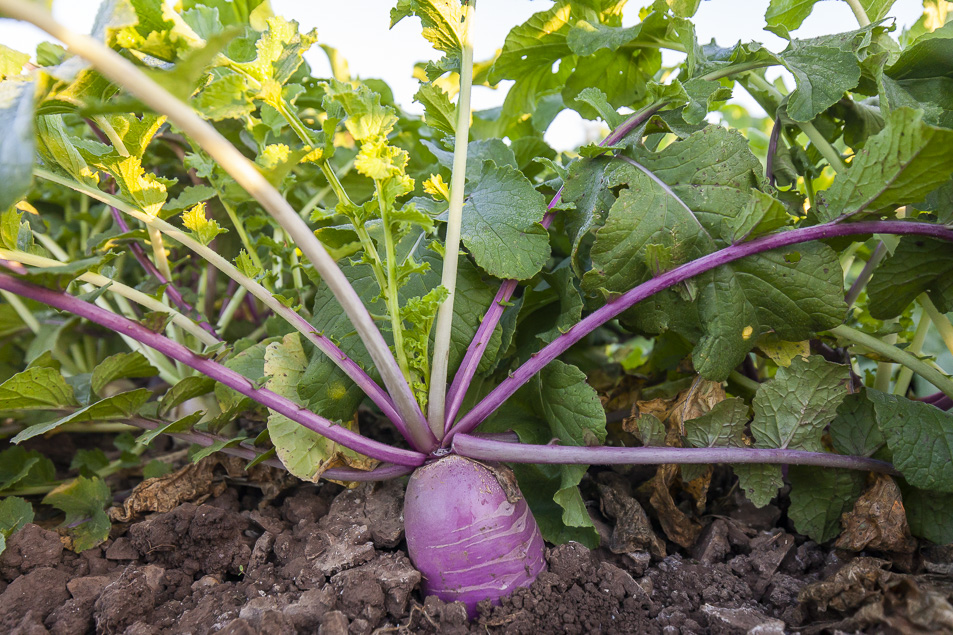 Is purple daikon a new vegetable to you? Follow Abby's advice and give it a try 3 times before hitting that swap button. It just might be your favorite new radish. Photo by Scott.
Is purple daikon a new vegetable to you? Follow Abby's advice and give it a try 3 times before hitting that swap button. It just might be your favorite new radish. Photo by Scott.CSA BOX CONTENTS WEEK OF JAN 27TH
01/28/20 — Scott
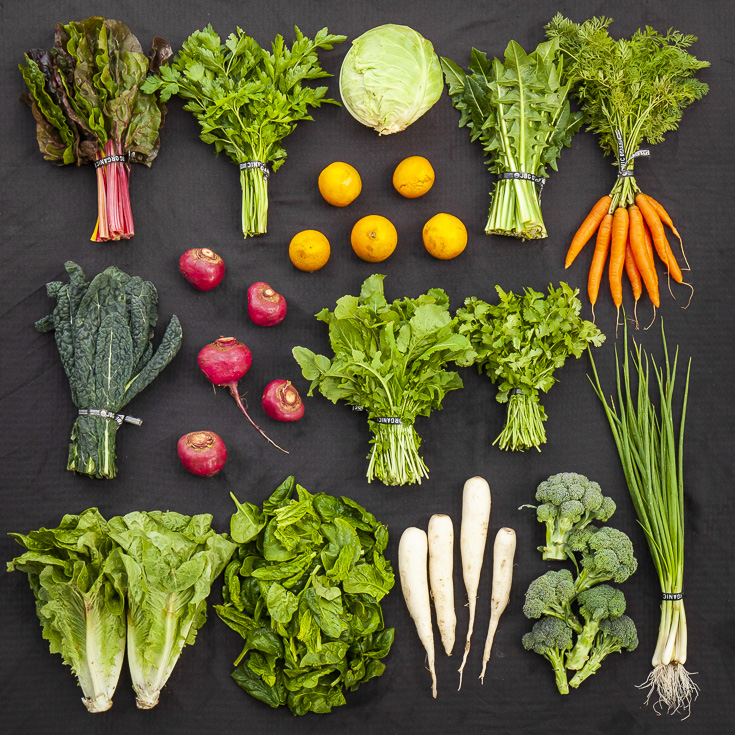 CSA Box Contents Week of Jan 27th
CSA Box Contents Week of Jan 27th
Large Box
Beets
Broccoli
Cabbage
Carrot, Orange
Cauliflower
Greens, Kale, Curly
Greens, Mustard
Greens, Spinach
Herb, Cilantro
Lettuce, Romaine
Onion, Spring White
Radish, French Breakfast
Beets
Broccoli
Cabbage
Carrot, Orange
Cauliflower
Greens, Kale, Curly
Greens, Mustard
Greens, Spinach
Herb, Cilantro
Lettuce, Romaine
Onion, Spring White
Radish, French Breakfast
Medium Box
Beets
Broccoli
Cabbage
Carrot, Orange
Greens, Kale, Curly
Greens, Mustard
Herb, Parsley, Flat
Lettuce, Romaine
Onion, Multiplying
Turnip, White Japanese
Beets
Broccoli
Cabbage
Carrot, Orange
Greens, Kale, Curly
Greens, Mustard
Herb, Parsley, Flat
Lettuce, Romaine
Onion, Multiplying
Turnip, White Japanese
Small Box
Broccoli
Carrot, Orange
Cauliflower
Greens, Chard, Rainbow
Greens, Kale, Curly
Herb, Cilantro
Onion, Spring White
Broccoli
Carrot, Orange
Cauliflower
Greens, Chard, Rainbow
Greens, Kale, Curly
Herb, Cilantro
Onion, Spring White
Individual Box
Beets
Broccoli
Carrot, Orange
Cauliflower
Greens, Chard, Rainbow
Onion, Spring White
Beets
Broccoli
Carrot, Orange
Cauliflower
Greens, Chard, Rainbow
Onion, Spring White
CSA BOX CONTENTS WEEK OF JAN 27TH
01/28/20 — Scott
 CSA Box Contents Week of Jan 27th
CSA Box Contents Week of Jan 27th
Large Box
Broccoli
Cabbage
Carrots
Citrus, Mixed
Greens, Chard, Rainbow
Greens, Kale, Dino
Herb, Cilantro
Lettuce, Romaine
Onion, Multiplying
Roasting Veggies
Turnip, Scarlett
FRENCH GRATED CARROT SALAD
01/30/20 — Ada Broussard
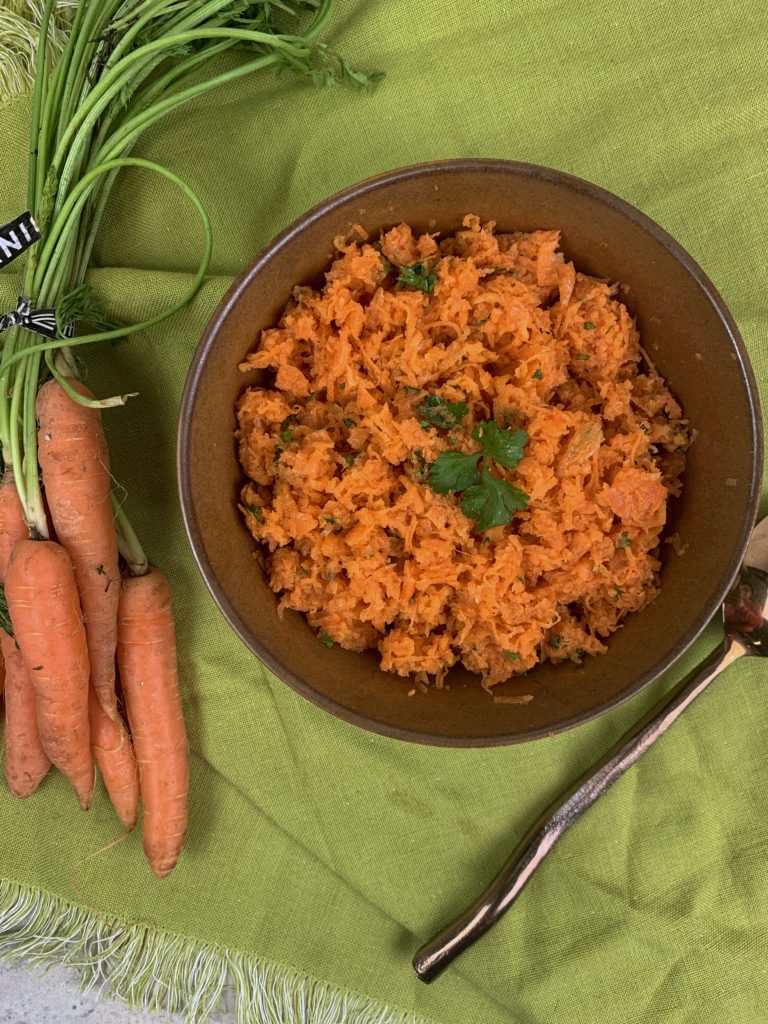 French Grated Carrot Salad
French Grated Carrot Salad
Servings: 2-4 Total Time: 15 minutes Author: The Migoni Kitchen
This is such a common salad all over France. I grew up eating it every summer visiting my grandparents. It’s so incredibly simple and great way to highlight carrots. A great picnic salad or to pair with any protein. We use a food processor to grate the carrots, but a box grated can also be used.
Ingredients:
- 1 lb carrots, grated finely
- 2 tbsp white vinegar or apple cider vinegar
- 2 tbsp olive oil
- 1/2 tsp lemon juice
- 1/4 tsp black pepper
- 1/2 tsp Kosher salt
- 1 tbsp fresh parsley
FIELD UPDATE FROM BRENTON
01/31/20 — Ada Broussard
We sat down with Brenton this week and got the lowdown on happenings in the field. Per usual, there are a lot of happenings.
![]() Early morning manager meetings in the shelter of the greenhouse. Photo by Scott David Gordon.
Early morning manager meetings in the shelter of the greenhouse. Photo by Scott David Gordon.
Planting This is “go time” at the farm, and things are “really getting crazy”, according to Brenton. It goes without saying. All that beautiful spring bounty that you expect from farms? Well, that bounty is all being planted, now, and before it can be planted, it must be seeded, beds must be prepped, drip tape laid, and compost spread. Our greenhouse, as well as our hardening-off area outside the greenhouse, are full of transplants that need to be planted including fennel, leeks, kale, as well as brassicas like cabbage, broccoli, and cauliflower. Last week we got rained out on several days, so we’re a bit behind schedule with these transplants. We’re also trying to get our potatoes in the ground, which take about two weeks for their greens to poke out from the earth, and should be planted around two weeks before the average last frost. Which, believe it or not, is quickly approaching!
![]() Transplants hardening off outside our greenhouse, waiting for their turn to go into the ground. Photo by Scott David Gordon.
Transplants hardening off outside our greenhouse, waiting for their turn to go into the ground. Photo by Scott David Gordon.
In addition to trying to get our transplants and potatoes in the ground, we’re also beginning to gear up for another large round of direct seeded crops like beets and carrots. The weather hasn’t been perfect for direct seeding - the ground is a bit too damp in some areas of the farm and we’re having to be conservative… even though the ticking clock and a general sense of spring-fever has us wanting to plant, plant, plant.
Crops This has been a mild winter. Without pouring over data to confirm, we’ll go ahead and say that this definitely feels like the warmest and mildest winter we’ve had as a farm. Though our farm crews’ fingertips may benefit from this warmer weather, our cool-season crops haven’t had the same luck.
Case in point: beets. Which, are back! (Finally!) If you’re a CSA Member or market patron, you may have noticed the mysterious absence of beets in your JBG haul, a crop that usually defines our fall and winter season. We planted three large rounds of beets, begging in early fall, that all failed. Round one didn’t germinate properly due to the really hot weather that extended into the fall. Round two germinated beautifully! And then, came the hogs. They decimated our second planting of beets. Round three of beets was plagued by army worms, a pest that is usually deterred by the cold, but without any extreme cold, the worms prevailed. Unfortunately, this march of army worms hit at an extremely busy time in the fall (when we were busy fighting weeds), and we just didn’t have the staff to properly deal with the pests. Goodbye, round three. Lucky for us, the fourth time was a charm, and beets of all colors were harvested every day this week.
![]() Beets are finally here. Have you missed them like we have? Photo by Scott David Gordon.
Beets are finally here. Have you missed them like we have? Photo by Scott David Gordon.
Army worms aren’t the only pest that has thrived in this mild winter. The thrips, a pest that we usually expect to surface when the weather warms in late February, have made an extremely early appearance and are attaching themselves to our spring onion crop, their favorite feast. We’ll be fighting this generation of thrips hard, using neem oil and an extract from made from dried chrysanthemum flower heads called pyrethrum. Thrips, begone! Army worms, thrips, flea beetles… a lot of these bug populations usually get reduced by the cold weather, but with this mild winter we’re having, the bugs are here to test us.
![]() Look closely at this beautiful photo and you'll see tiny yellow bugs. These are thrips. If a few hitch a ride into your CSA box, don't worry: they're not dangerous and are merely annoying. Rinse them off, and continue on. Photo by Scott David Gordon.
Look closely at this beautiful photo and you'll see tiny yellow bugs. These are thrips. If a few hitch a ride into your CSA box, don't worry: they're not dangerous and are merely annoying. Rinse them off, and continue on. Photo by Scott David Gordon.
Equipment The one thing that tested us more than the bugs this week? Some of our equipment, specifically, our equipment that falls in the “antique” category. As we mentioned, it’s go-time for the direct seeing of our spring carrots and beets. This week, our beds were ready to go but surprisingly, our MaterMac seeder was not. Back when we first purchased this seeder, MaterMac was based in Italy, but has since then been sold to another company. Parts are hard to get, and even harder when you have a very old model, like ours. One MaterMac dealer is on the east coast, the other on the west coast, and after countless hours on the phone with each we learned that neither dealer had what we needed. In fact, we were originally told that the universal coupling we needed to make our seeder run “was obsolete, and did not exist”, which was a problem, because we needed not one of the couplings, but two.But, farmers aren’t really the giving-up type. We persisted, and learned that the west coast dealer had half of the assembly, and the east coast dealer had one whole assembly. With the parts that we still had at the farm, we were able to cobble together the other half, and after hours on the phone and two next-day air shipments, we were back in action.
![]() Jack, armed with a cell phone and spread sheets, scours the country for parts. Photo by Scott David Gordon.
Jack, armed with a cell phone and spread sheets, scours the country for parts. Photo by Scott David Gordon.
![]() Our Italian amico, the MaterMac. Photo by Scott David Gordon.
Our Italian amico, the MaterMac. Photo by Scott David Gordon.
This type of problem solving is typical… in fact, the seeder couplings weren’t the only parts we hunted for this week. The most geriatric tractor on our farm in our Case tractor, which is still the primary tractor we use for cultivation. It’s pretty common that we need to tinker with this sweet (but temperamental) tractor to get it started up, and this week whilst tinkering, we accidentally dropped a wrench in its depths and the radiator fan shattered.
Did we mention this tractor was old and special? We must have called 40 different places looking for a replacement radiator fan, but no one seemed to exist across the whole country. Finally, we found someone in Tennessee selling the identical, antique tractor. “All we need is the radiator fan. Can we buy that from you?” “Yep! For a hundred dollar bill!”. One Benjamin and another next-day air shipment later, and we were back in business.
![]() How could you ever be mad at this tractor? Photo by Scott David Gordon.
How could you ever be mad at this tractor? Photo by Scott David Gordon.
Looking Forward Tracy, one of our Hergotz managers, said it best this week, “There is so much positive momentum right now.” We are finishing harvesting some of our fall and winter plantings right now and are eager to get a fresh start this spring. Some of the crops you see right now might have a few tiny bug bites or might have edges that have been burned from an occasional freeze. We hope that these are friendly reminders that you’re eating organic produce, that is grown locally - produce that is unable to escape the realities of a particular weather season, and produce that also happens to be fresher and taste better than your average item from a grocery store.
The vegetables we grow may not always look perfect, especially at a moment like this, in between seasons and plantings when bugs are having a party, but this produce is not only nutritionally dense… it’s also delicious. When any degree of cold weather hits, our crops get busy converting some of their cells to a more sugary-version of themselves, yielding a sweeter and more delicious crop for you. Most of our crops are harvested one day, and delivered the next. They’re fresh as all get-up. If you’re new to eating local produce, it might take some time to shake the perfect standards that grocery stores have reinforced. These same standards, unfortunately, have been the cause of a vast amount of waste in our food system. To be clear, we don't want to have produce that ever looks damaged, but perfect produce comes at a financial cost to farms: it costs more fuel to drive over fields, to do another pest spray, all the while harming beneficial insects in the process.
We strive to strike a balance here, and we hope our update from the fields this week demonstrates all the figuring and phone calls that goes into creating that balance. Thanks for reading, and as always, thanks for supporting the farm.
![]() "What do you mean the seeder is broken?" Photo by Scott David Gordon.
"What do you mean the seeder is broken?" Photo by Scott David Gordon.
P.S. Speaking of positive momentum, are you planting a spring garden this year? If you’ve made it to the bottom of this post, you’ll be the first to know a little secret: Our Spring Transplant Sale is going live next week! Keep your eyes peeled!
 Early morning manager meetings in the shelter of the greenhouse. Photo by Scott David Gordon.
Early morning manager meetings in the shelter of the greenhouse. Photo by Scott David Gordon.
Planting This is “go time” at the farm, and things are “really getting crazy”, according to Brenton. It goes without saying. All that beautiful spring bounty that you expect from farms? Well, that bounty is all being planted, now, and before it can be planted, it must be seeded, beds must be prepped, drip tape laid, and compost spread. Our greenhouse, as well as our hardening-off area outside the greenhouse, are full of transplants that need to be planted including fennel, leeks, kale, as well as brassicas like cabbage, broccoli, and cauliflower. Last week we got rained out on several days, so we’re a bit behind schedule with these transplants. We’re also trying to get our potatoes in the ground, which take about two weeks for their greens to poke out from the earth, and should be planted around two weeks before the average last frost. Which, believe it or not, is quickly approaching!
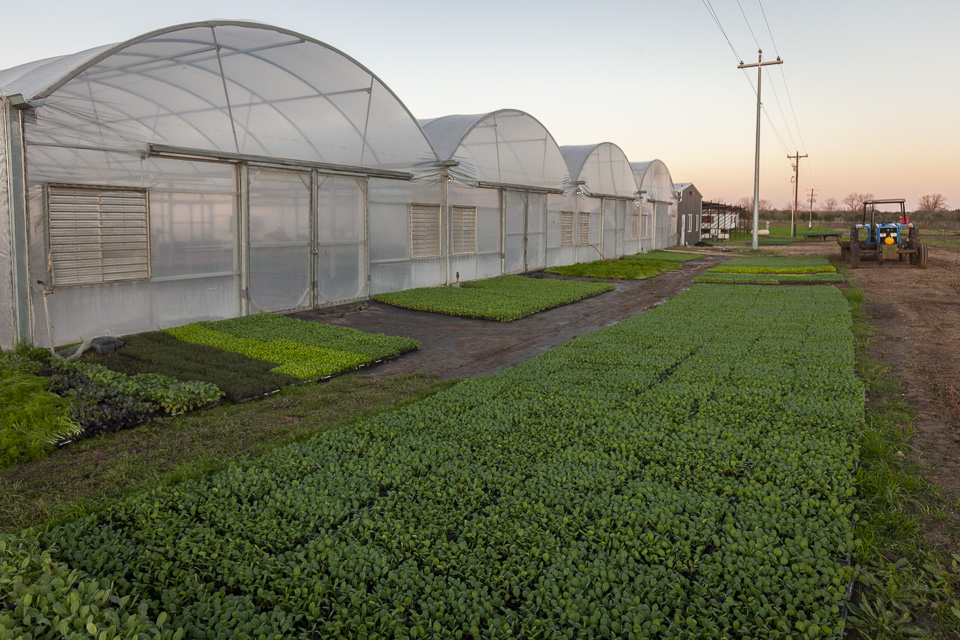 Transplants hardening off outside our greenhouse, waiting for their turn to go into the ground. Photo by Scott David Gordon.
Transplants hardening off outside our greenhouse, waiting for their turn to go into the ground. Photo by Scott David Gordon.
In addition to trying to get our transplants and potatoes in the ground, we’re also beginning to gear up for another large round of direct seeded crops like beets and carrots. The weather hasn’t been perfect for direct seeding - the ground is a bit too damp in some areas of the farm and we’re having to be conservative… even though the ticking clock and a general sense of spring-fever has us wanting to plant, plant, plant.
Crops This has been a mild winter. Without pouring over data to confirm, we’ll go ahead and say that this definitely feels like the warmest and mildest winter we’ve had as a farm. Though our farm crews’ fingertips may benefit from this warmer weather, our cool-season crops haven’t had the same luck.
Case in point: beets. Which, are back! (Finally!) If you’re a CSA Member or market patron, you may have noticed the mysterious absence of beets in your JBG haul, a crop that usually defines our fall and winter season. We planted three large rounds of beets, begging in early fall, that all failed. Round one didn’t germinate properly due to the really hot weather that extended into the fall. Round two germinated beautifully! And then, came the hogs. They decimated our second planting of beets. Round three of beets was plagued by army worms, a pest that is usually deterred by the cold, but without any extreme cold, the worms prevailed. Unfortunately, this march of army worms hit at an extremely busy time in the fall (when we were busy fighting weeds), and we just didn’t have the staff to properly deal with the pests. Goodbye, round three. Lucky for us, the fourth time was a charm, and beets of all colors were harvested every day this week.
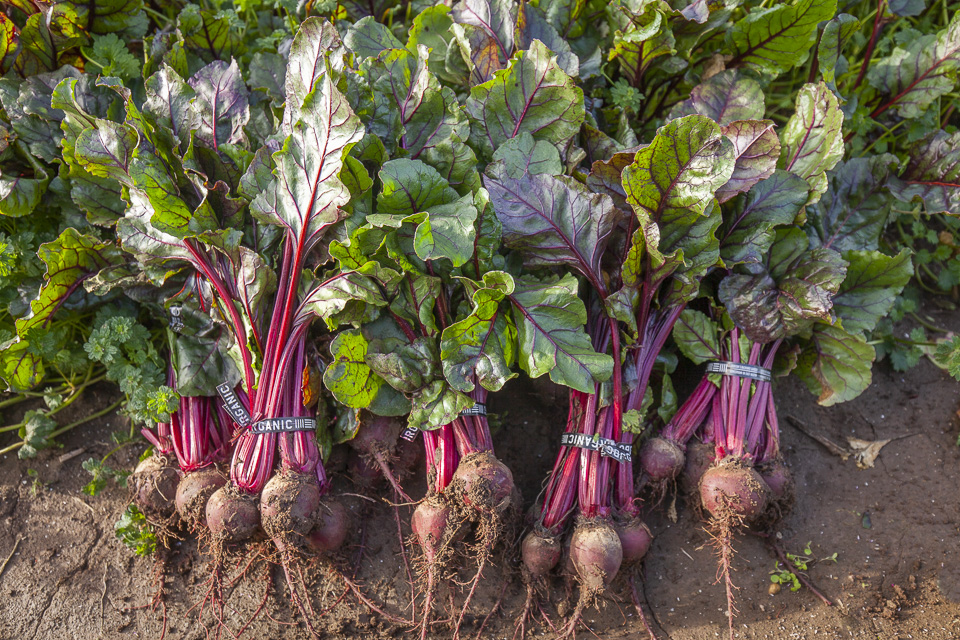 Beets are finally here. Have you missed them like we have? Photo by Scott David Gordon.
Beets are finally here. Have you missed them like we have? Photo by Scott David Gordon.
Army worms aren’t the only pest that has thrived in this mild winter. The thrips, a pest that we usually expect to surface when the weather warms in late February, have made an extremely early appearance and are attaching themselves to our spring onion crop, their favorite feast. We’ll be fighting this generation of thrips hard, using neem oil and an extract from made from dried chrysanthemum flower heads called pyrethrum. Thrips, begone! Army worms, thrips, flea beetles… a lot of these bug populations usually get reduced by the cold weather, but with this mild winter we’re having, the bugs are here to test us.
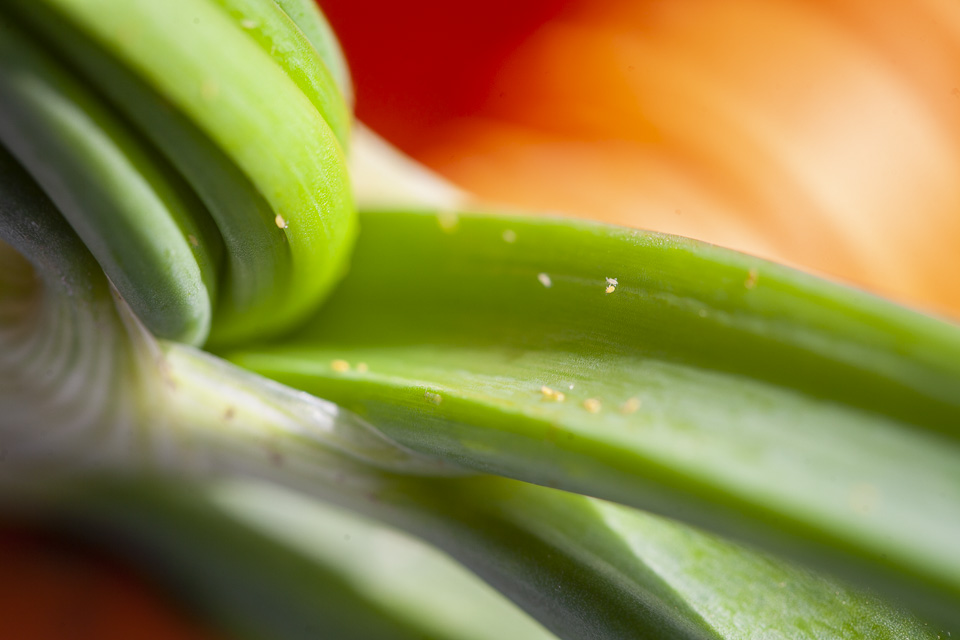 Look closely at this beautiful photo and you'll see tiny yellow bugs. These are thrips. If a few hitch a ride into your CSA box, don't worry: they're not dangerous and are merely annoying. Rinse them off, and continue on. Photo by Scott David Gordon.
Look closely at this beautiful photo and you'll see tiny yellow bugs. These are thrips. If a few hitch a ride into your CSA box, don't worry: they're not dangerous and are merely annoying. Rinse them off, and continue on. Photo by Scott David Gordon.
Equipment The one thing that tested us more than the bugs this week? Some of our equipment, specifically, our equipment that falls in the “antique” category. As we mentioned, it’s go-time for the direct seeing of our spring carrots and beets. This week, our beds were ready to go but surprisingly, our MaterMac seeder was not. Back when we first purchased this seeder, MaterMac was based in Italy, but has since then been sold to another company. Parts are hard to get, and even harder when you have a very old model, like ours. One MaterMac dealer is on the east coast, the other on the west coast, and after countless hours on the phone with each we learned that neither dealer had what we needed. In fact, we were originally told that the universal coupling we needed to make our seeder run “was obsolete, and did not exist”, which was a problem, because we needed not one of the couplings, but two.But, farmers aren’t really the giving-up type. We persisted, and learned that the west coast dealer had half of the assembly, and the east coast dealer had one whole assembly. With the parts that we still had at the farm, we were able to cobble together the other half, and after hours on the phone and two next-day air shipments, we were back in action.
 Jack, armed with a cell phone and spread sheets, scours the country for parts. Photo by Scott David Gordon.
Jack, armed with a cell phone and spread sheets, scours the country for parts. Photo by Scott David Gordon.
 Our Italian amico, the MaterMac. Photo by Scott David Gordon.
Our Italian amico, the MaterMac. Photo by Scott David Gordon.
This type of problem solving is typical… in fact, the seeder couplings weren’t the only parts we hunted for this week. The most geriatric tractor on our farm in our Case tractor, which is still the primary tractor we use for cultivation. It’s pretty common that we need to tinker with this sweet (but temperamental) tractor to get it started up, and this week whilst tinkering, we accidentally dropped a wrench in its depths and the radiator fan shattered.
Did we mention this tractor was old and special? We must have called 40 different places looking for a replacement radiator fan, but no one seemed to exist across the whole country. Finally, we found someone in Tennessee selling the identical, antique tractor. “All we need is the radiator fan. Can we buy that from you?” “Yep! For a hundred dollar bill!”. One Benjamin and another next-day air shipment later, and we were back in business.
 How could you ever be mad at this tractor? Photo by Scott David Gordon.
How could you ever be mad at this tractor? Photo by Scott David Gordon.
Looking Forward Tracy, one of our Hergotz managers, said it best this week, “There is so much positive momentum right now.” We are finishing harvesting some of our fall and winter plantings right now and are eager to get a fresh start this spring. Some of the crops you see right now might have a few tiny bug bites or might have edges that have been burned from an occasional freeze. We hope that these are friendly reminders that you’re eating organic produce, that is grown locally - produce that is unable to escape the realities of a particular weather season, and produce that also happens to be fresher and taste better than your average item from a grocery store.
The vegetables we grow may not always look perfect, especially at a moment like this, in between seasons and plantings when bugs are having a party, but this produce is not only nutritionally dense… it’s also delicious. When any degree of cold weather hits, our crops get busy converting some of their cells to a more sugary-version of themselves, yielding a sweeter and more delicious crop for you. Most of our crops are harvested one day, and delivered the next. They’re fresh as all get-up. If you’re new to eating local produce, it might take some time to shake the perfect standards that grocery stores have reinforced. These same standards, unfortunately, have been the cause of a vast amount of waste in our food system. To be clear, we don't want to have produce that ever looks damaged, but perfect produce comes at a financial cost to farms: it costs more fuel to drive over fields, to do another pest spray, all the while harming beneficial insects in the process.
We strive to strike a balance here, and we hope our update from the fields this week demonstrates all the figuring and phone calls that goes into creating that balance. Thanks for reading, and as always, thanks for supporting the farm.
 "What do you mean the seeder is broken?" Photo by Scott David Gordon.
"What do you mean the seeder is broken?" Photo by Scott David Gordon.
P.S. Speaking of positive momentum, are you planting a spring garden this year? If you’ve made it to the bottom of this post, you’ll be the first to know a little secret: Our Spring Transplant Sale is going live next week! Keep your eyes peeled!
PHOTOS FROM THE FARM: 1.31.2020
01/31/20 — Ada Broussard
It's hard to believe the first month of 2020 is coming to a close. But, if you read this week's blog post, you'll know that there's really no time to be sentimental. Thanks to our amazing farm photographer, Scott David Gordon, for capturing this week's happenings so well.
![]() Carrots that make you want to go bunny. Photo by Scott David Gordon.
Carrots that make you want to go bunny. Photo by Scott David Gordon.
![]() Cleaning up our green onions is wet work. Photo by Scott David Gordon.
Cleaning up our green onions is wet work. Photo by Scott David Gordon.
![]() Luke calculating and documenting his fertigation plan for the onions. Photo by Scott David Gordon.
Luke calculating and documenting his fertigation plan for the onions. Photo by Scott David Gordon.
![]() We still have a couple onions to plant.... Photo by Scott David Gordon.
We still have a couple onions to plant.... Photo by Scott David Gordon.
![]() Spinach for the people. Photo by Scott David Gordon.
Spinach for the people. Photo by Scott David Gordon.
![]() Greenhouse etiquette 101: Don't forget to close the door! Photo by Scott David Gordon.
Greenhouse etiquette 101: Don't forget to close the door! Photo by Scott David Gordon.
![]() Welcome back, beets. It's great to see ya! Photo by Scott David Gordon.
Welcome back, beets. It's great to see ya! Photo by Scott David Gordon.
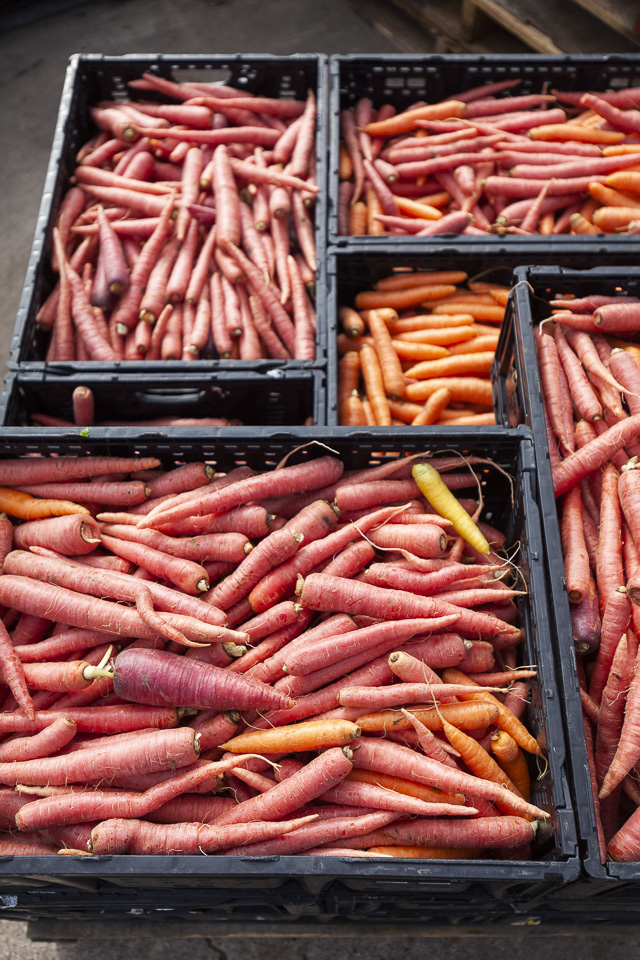 Carrots that make you want to go bunny. Photo by Scott David Gordon.
Carrots that make you want to go bunny. Photo by Scott David Gordon.
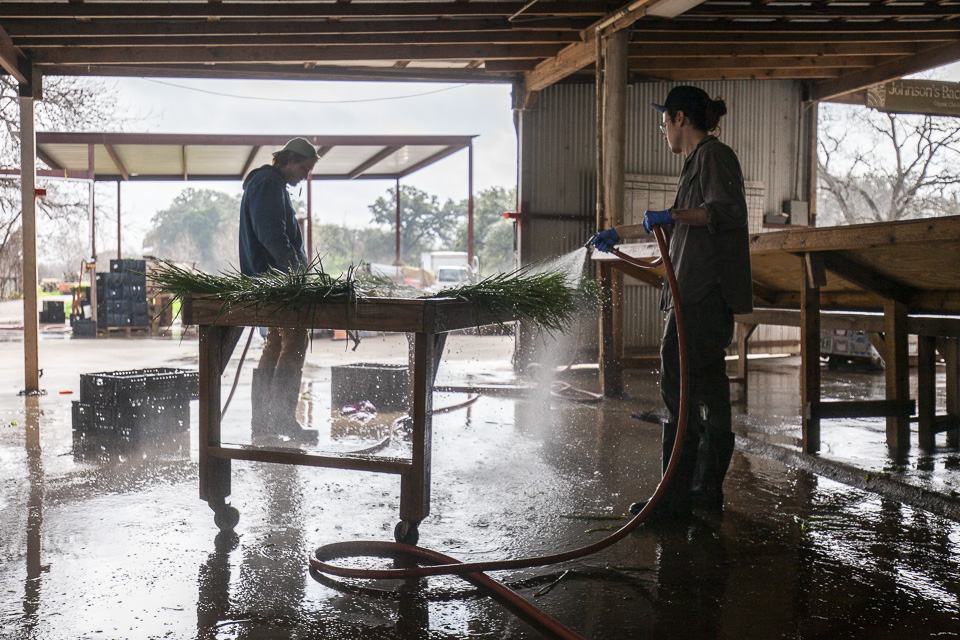 Cleaning up our green onions is wet work. Photo by Scott David Gordon.
Cleaning up our green onions is wet work. Photo by Scott David Gordon.
 Luke calculating and documenting his fertigation plan for the onions. Photo by Scott David Gordon.
Luke calculating and documenting his fertigation plan for the onions. Photo by Scott David Gordon.
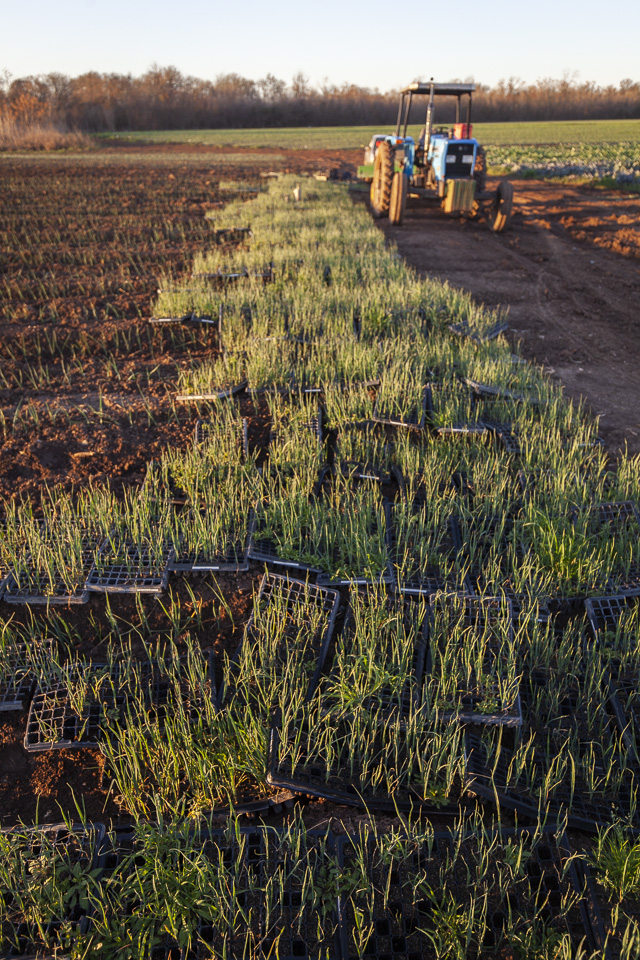 We still have a couple onions to plant.... Photo by Scott David Gordon.
We still have a couple onions to plant.... Photo by Scott David Gordon.
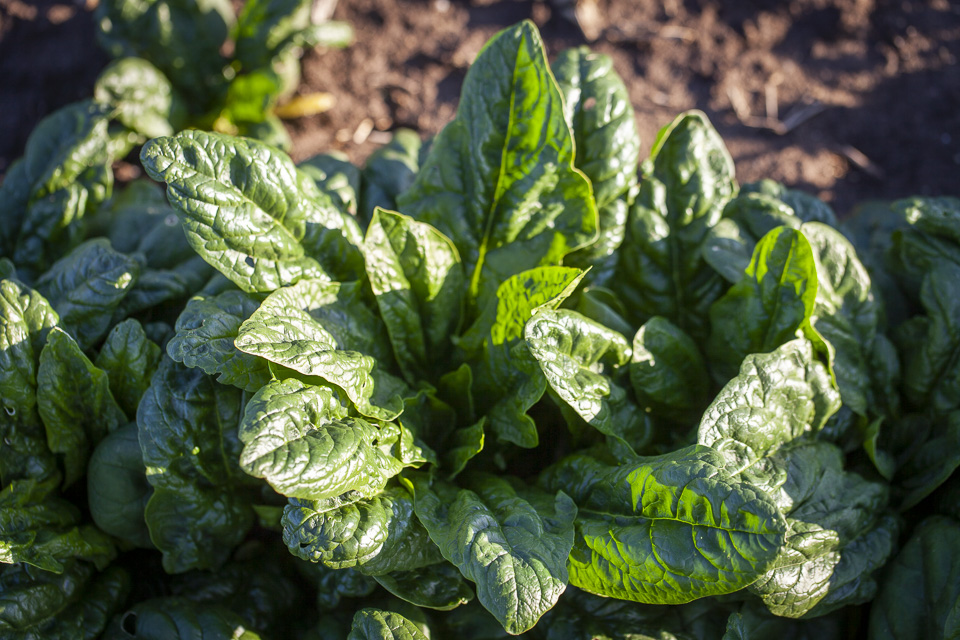 Spinach for the people. Photo by Scott David Gordon.
Spinach for the people. Photo by Scott David Gordon.
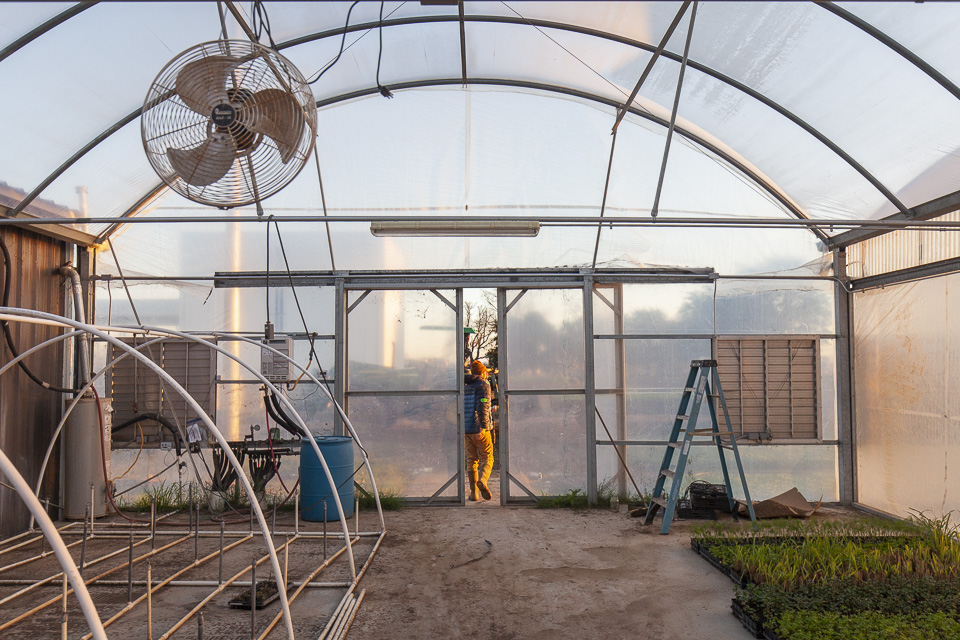 Greenhouse etiquette 101: Don't forget to close the door! Photo by Scott David Gordon.
Greenhouse etiquette 101: Don't forget to close the door! Photo by Scott David Gordon.
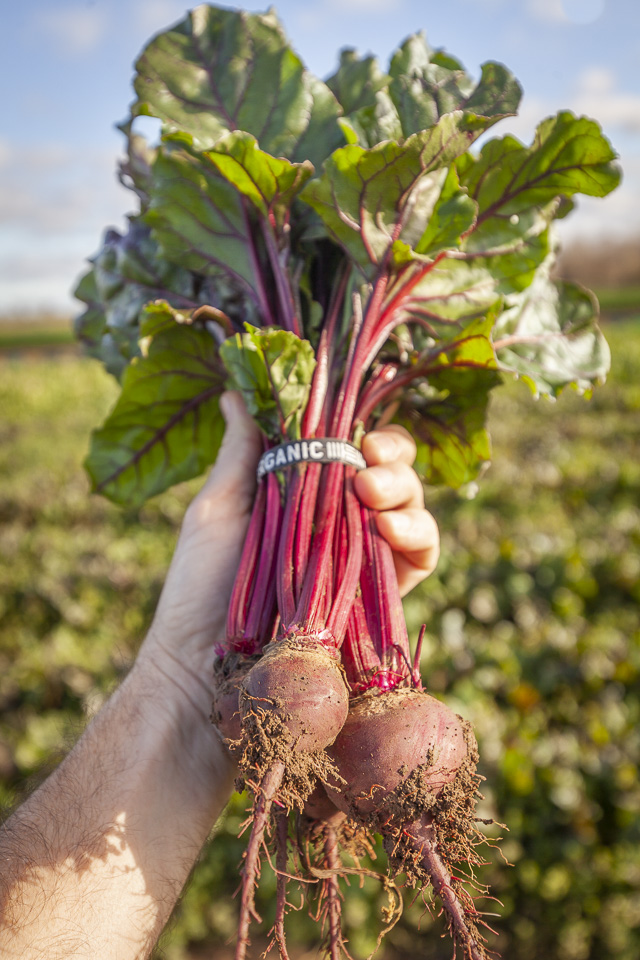 Welcome back, beets. It's great to see ya! Photo by Scott David Gordon.
Welcome back, beets. It's great to see ya! Photo by Scott David Gordon.





 0 ITEMS IN CART
0 ITEMS IN CART 

